
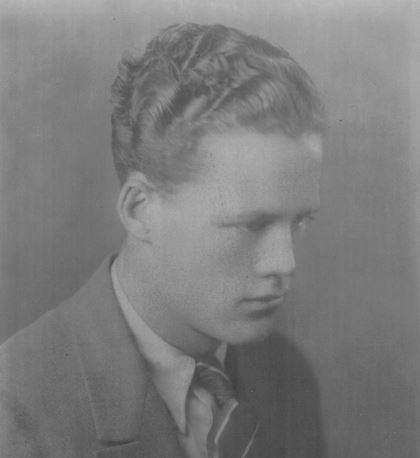
John Edgar Fike, Sr. 1907-1970
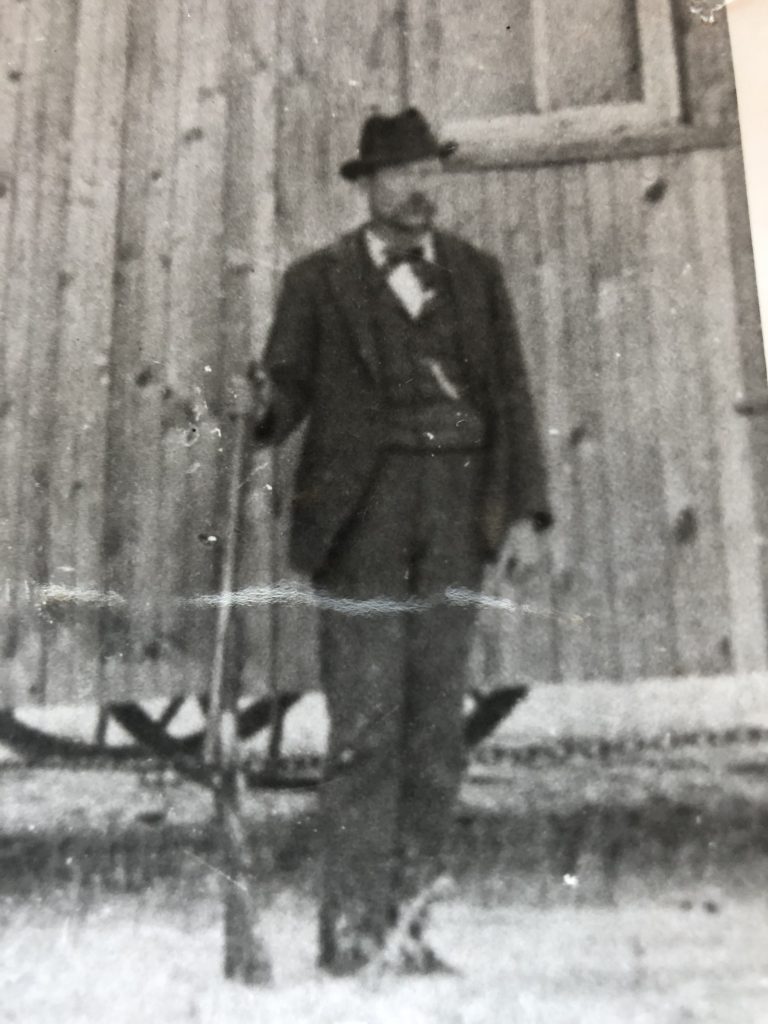
Josiah Walter Fike 1863-1924

Ethel May McMonegal 1876-1942

Thomas Lanman Fike 1834-1910

Frances Catherine Henry 1837-1883
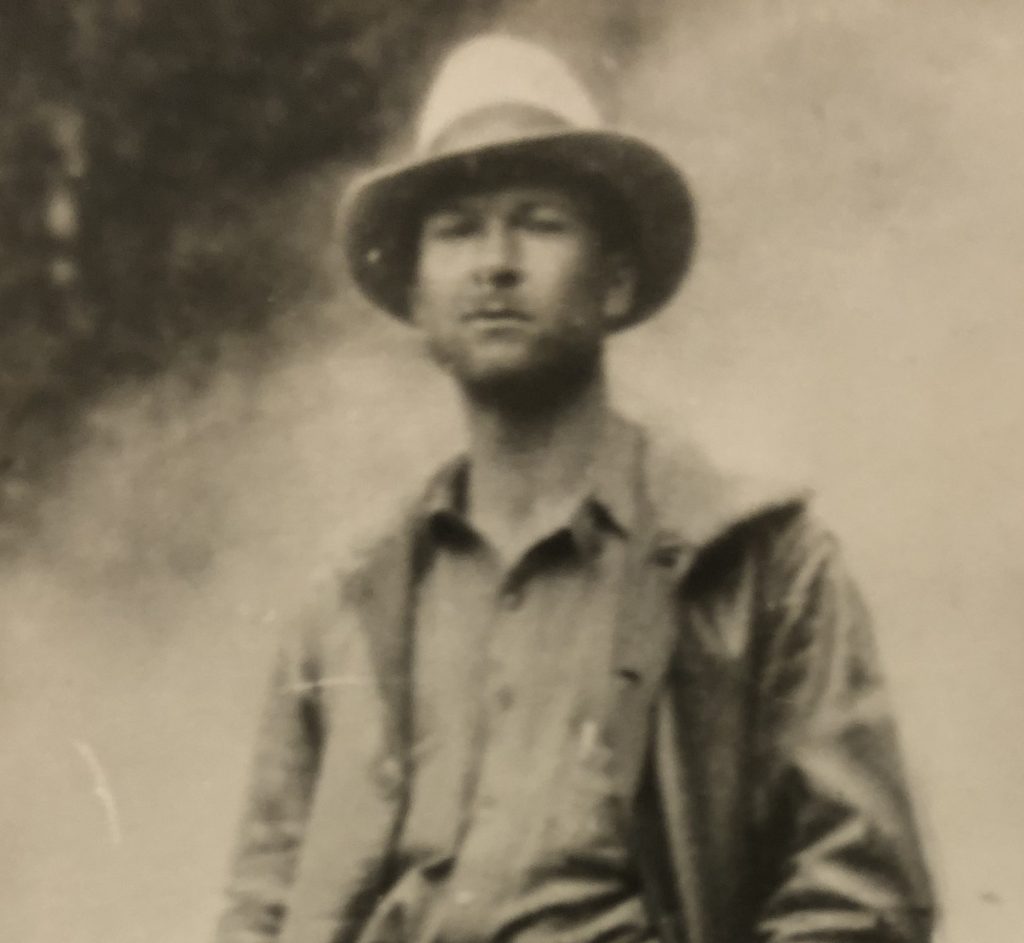
James McMonegal 1841-1909
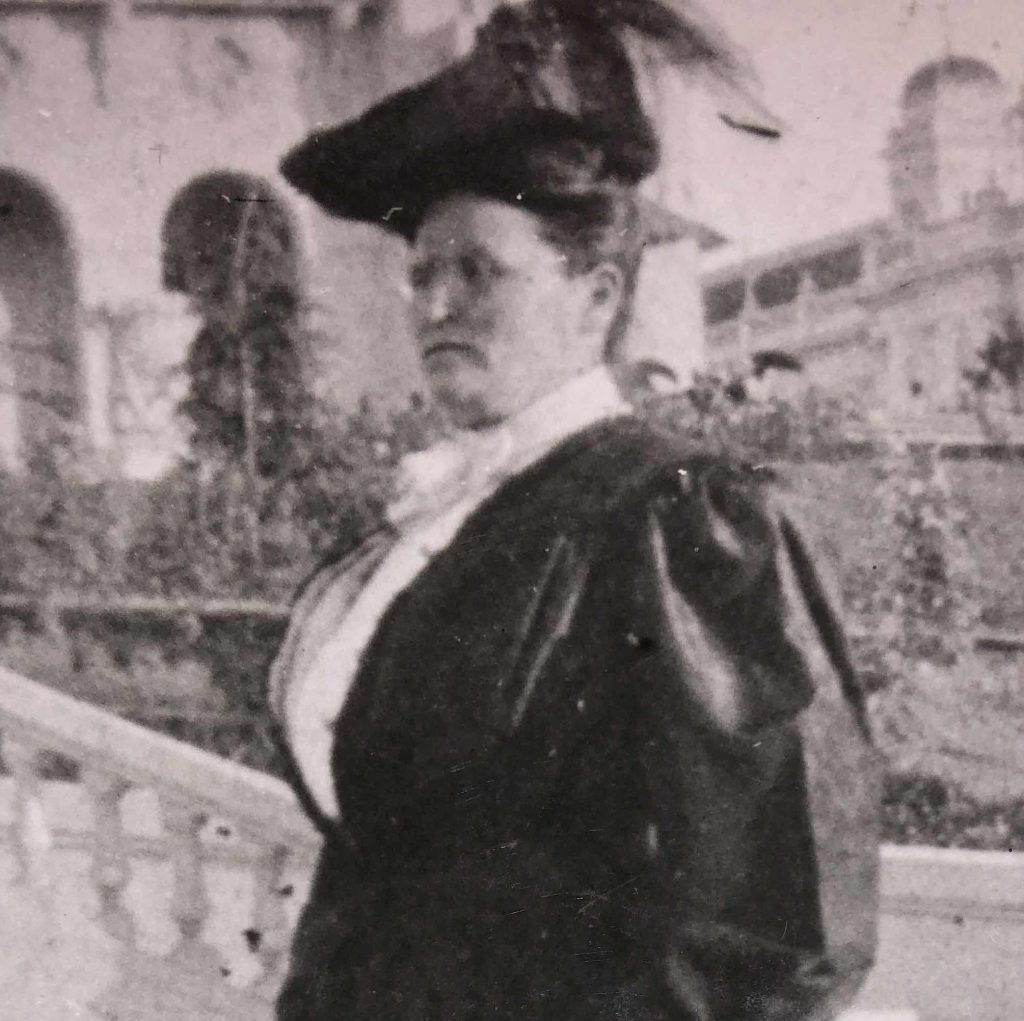
Henrietta Bellen 1855-1936

Josiah Achem Fyke 1791-1860

Elizabeth Richardson 1789-1850

Thomas Henry 1911-1876

Sarah Stark 1819-1900

James McMonegal

Uness
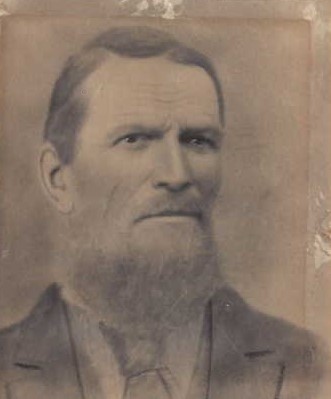
Anthony Bellen 1823-1903
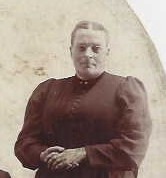
Electa England 1833-1925
The arrow on the right of the following panels will expand the sections:
Detailed Pedigree Chart
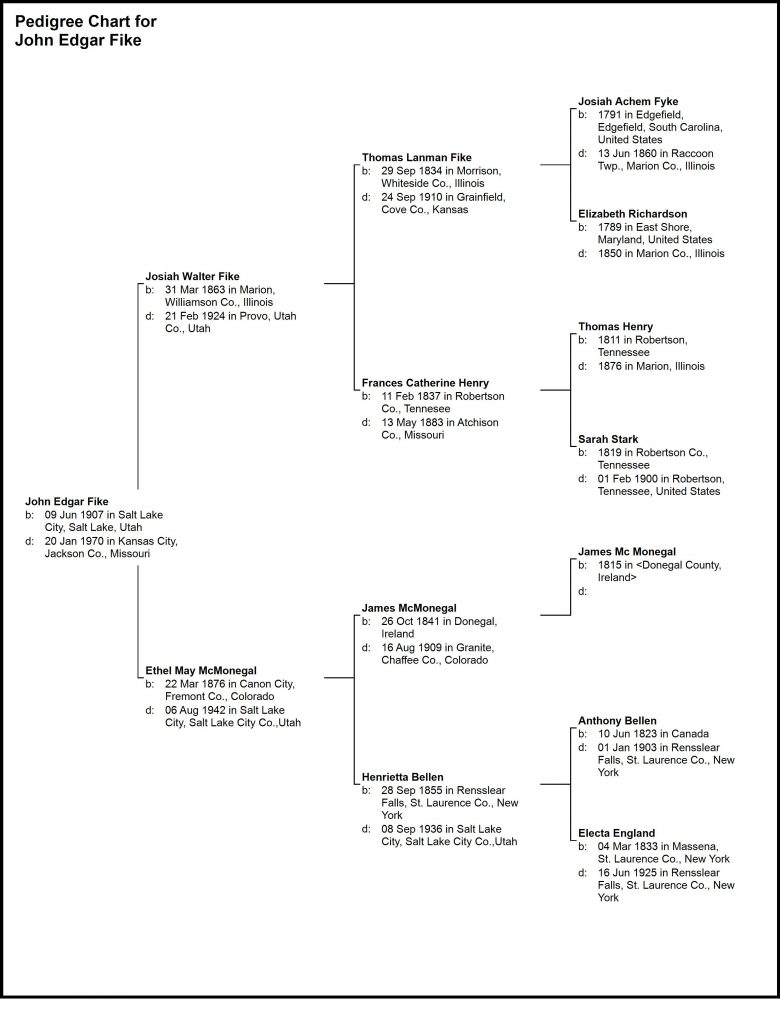
Our Earliest Known Fike Ancestors – John Thomas Fike (1718-1788) Elizabeth Sarah Malachi Fike (1715-1790)
John Thomas Fike (1718-1788) Elizabeth Sarah Malachi Fike (1715-1790)
We will start the exploration of this branch of our family tree with our earliest known Fike ancestor – John Thomas Fike 1718-1788. We don’t yet know who his parents were or when the First of his ancestors arrived in America. Some researchers think that Fike was a misspelling of Fitch and that they came from an aristocratic English line. There are some who believe that there is a connection with the well-researched Christian Fike line from Pennsylvania. There is another story that John Fike was one of three brothers that emigrated from Ireland. The most common story, and one that we will later read in the biographies of John’s descendants, is that our Fike family is from Germany and that they arrived in the colonies in the late 17th century. Below is an excerpt from a researcher about the early Fikes:
“The Fike Family are of a German heritage. In the German language, the name Fyke means a conical shaped fish trap or fish basket. The immigrant(s) most likely landed first at Philadelphia. There are Fike’s in Pennsylvania today. The Feick/Fike/Figg name was found all over Germany in the early 1700’s, and there are still many Feick/Fike names in German telephone books today….Our branch later moved south to North Carolina. The earliest record of our Fike family begins with John Fike, Constable of Granville County, North Carolina, in 1752. He had a Land Grant in Granville in 1760…”
In addition to the Fikes we will meet the Richardsons from Maryland who moved with the family to North Carolina, Tennessee, and on to Illinois. In Tennessee they married into the Henry clan in the early 1800s.
John Thomas Fike and his sons fought in the Regulator Movement in North Carolina, one of the first armed revolts of the colonists against the British Crown. They also fought in the North and South Carolina militias during the Revolutionary War. One of our uncles was in George Washington’s Continental Army and died while in service during the time that the army was encamped at Valley Forge. Another of our ancestors, Josiah Achem Fyke, fought for Andrew Jackson at the Battle of New Orleans during the war of 1812.
John moved from Virginia to North Carolina before the Revolution. The following generation took advantage of land grants that were offered to veterans and moved to Tennessee and Kentucky at the turn of the 19th century. From there the Fikes moved further west as lands were opened up in Illinois. Later generations moved to Missouri and then onto Utah.
John Thomas Fike was born about 1718 in Hanover Co., Virginia. He married Elizabeth Sarah Malachi in 1737 in Hanover County
Hanover County was formed in 1720 from New Kent County and is located in the east-central Piedmont and Coastal Plain between the Chickahominy and Pamunkey Rivers, Northwest of Richmond. Tobacco barges came up the Pamunkey River to Hanovertown to load and unload goods in an area which had been home to the Chickahominy and Pamunkey Indians.
Louisa County was formed in 1742 from Hanover County. It is immediately East of Albemarle where Jefferson’s Monticello is located. It was created from Hanover County and was named for Princess Louisa, youngest daughter of King George I.

Originally the county of Louisa was the home of elk, wolves and bears along with the Monasiccapanoe and Monacan Indian tribes but by 1700 these original inhabitants had left the area, opening it to settlement. The area’s late settlement was due to its location in an interior landlocked area of the Piedmont in Virginia and was very difficult to reach.
There are a few legal records that place John in Virginia. In Jun 1734 John Thomas Fike leased a tract of land in Hanover Co. Virginia from Shirley Whately (Edward P. Valentine Papers, Vol III). John married Elizabeth Sarah Malachi in Hanover Co. during the year 1737. On Feb. 2, 1746 John T. Fike witnessed a signed petition in Louisa County requesting that a road be cleared on the ridge between the South and North Anna rivers to Todd’s Pass. This suggests that he owned property in Louisa County. Before the Louisa County Court, John Fike was tried and acquitted on a count of the murder of Lewis Davis, the court deeming the entire event an accident. The Louisa County court record states that “John Fikes appeared in court being charged with killing Lewis Davis”.
Sometime between 1746 and 1752 John and Elizabeth relocated to North Carolina with their three oldest children, Malachi, Lucy, and James.
“It was during the “great migration” of the 1740s and 1750s, as a result of the impending hostilities between the Native Americans along the Pennsylvania and Virginia frontiers that would lead up to the French and Indian War (1756-1763), when the Virginians once again decided to move southward again, mostly into North Carolina, but a few made their way into South Carolina.
This “great migration” was made possible by the Great Wagon Road, which had been built across North Carolina from Virginia in the 1740s and 1750s. During the 1750s, the Fall Line Road and the Upper Road, which both originated at Fredericksburg, Virginia, were constructed deep into central North Carolina, again facilitating emigration from Virginia into North Carolina.
Many folks of all ethnic backgrounds soon learned of these new roads and of the cheap land that was available in the Piedmont and at the base of the Appalachian Mountains, and they came by the thousands from Pennsylvania, Maryland, Delaware, and most especially from all parts of Virginia.
Of course, not all of them could be tracked, but many groups of them could be followed. Some may have claimed to be included in the Scots-Irish numbers or the Quaker numbers instead of identifying themselves as merely Virginians, but they flocked to North Carolina in the Royal Period – again, primarily because of the impending French and Indian War and thanks to cheap land and low taxation.”
By 1752 John Thomas Fike was a Constable of Granville County, North Carolina. The 1755 Granville Co., NC tax list, p. 582 includes John Fike & Malaciah Fike, so Malachi was over 16 years of age, indicating his father was at least in his 30s. John and Elizabeth’s five youngest children, John, Nathan, Tyre (our ancestor), Elijah, and Elisha, were born in North Carolina from 1747 to 1754
John Fike claimed 200 acres on Bever Swamp and later 10 Dec 1755 he entered a claim for 640 acres. Malliciah Fike was a chain carrier when the property was surveyed on 20 May 1756 (Granville District of North Carolina 1748-1763, vol 4, no. 2743 by Margaret M. Hoffman) 1756 Survey, North Carolina Land Grant, entered 11 Mar 1760 , #257, 489 ac on NW side Bear Swamp in Granville Co., North Carolina, beg on said swamp at Charles Evey’s corner, chain carriers: Malachi Fike & Charles Evey. The 1757 Granville Co. tax lists: John Fike 1 White Male. In 1763 Granville Co., North Carolina, John Fike witnessed a deed.
John and Elizabeth lived the rest of their lives in the same area of west central North Carolina, but the names of the counties changed as the population grew and more counties were formed. In the early 1700s most of northwest North Carolina was Edgecombe County. Later the area became a part of Granville, then Orange, and finally Chatham County where John served as a constable.
John and his older children were supporters of the Regulator Movement in North Carolina in 1768:
“During the years leading up to the American Revolution many North Carolina people became strongly discontented with the way the provincial government was handling the colony’s affairs. However, their quarrel was not with the form of government or the colony’s laws but with abuses by government officials.
Grievances affecting the daily lives of the colonists included excessive taxes, dishonest sheriffs, and illegal fees. Scarcity of money contributed to the state of unrest. Those living in the western part of the province were isolated and unsympathetic with the easterners and it was in those frontier counties that the War of the Regulation began.
Minor clashes occurred until the spring of 1768, when an association of “Regulators” was formed. Wealthier colonists considered them to be a mob. The Regulators never had an outstanding leader, though several men were prominent in the movement; including James Hunter, Rednap Howell, William Butler, and Herman Husband. Husband, a Quaker and follower of Benjamin Franklin, circulated political pamphlets advocating peaceful reform.
Discouraged over failing to secure justice through peaceful negotiations, the reformers took a more radical stand. Violence, lawlessness, and terrorism reigned. When the government retaliated against them, the Regulators defiantly refused to pay fees, terrorized those who administered the law, and disrupted court proceedings.
It fell to royal governor William Tryon to bring the backcountry revolt to a speedy conclusion. In March 1771, the governor’s council advised Tryon to call out the militia and march against the rebel farmers.
The Battle of Alamance
The battle began on May 16 after the Regulators rejected Tryon’s suggestion that they disperse peacefully. Lacking leadership, organization, and adequate arms and, ammunition the Regulators were no match for Tryon’s militia. Many Regulators fled, leaving their bolder comrades to fight on.
The rebellion of the Regulators was crushed. Nine members of the king’s militia were killed and 61 wounded. The Regulator losses were much greater, though exact numbers are unknown. Tryon took 15 prisoners; seven were hung later. Many Regulators moved on to other frontier areas beyond North Carolina. Those who stayed were offered pardons by the governor in exchange for pledging an oath of allegiance to the royal government.
The War of the Regulation illustrates how dissatisfied much of the population was during the days before the American Revolution. The boldness displayed by reformers opposed to royal authority provided a lesson in the use of armed resistance, which patriots employed a few short years later in the American War for Independence.”
John Fike also served in the North Carolina militia providing unspecified services to the Revolutionary Army. In 1776 he was 58 years old.
John lived to the ripe old age of 70 and died in 1788 in Chatham County, North Carolina. The 1790 census of Chatham Co., North Carolina shows Elizabeth Fike, widow with 5 children living in the Hillsborough District. Elizabeth followed her husband to the grave later that year.

The first complete US census in 1790 also lists Malachi Fike as a landowner and taxpayer. A John Fike and Elijah were in Chatham County, North Carolina; Elisha Fike was in Burke County and a John Fike was in law enforcement work in Granville County. According to the records, James Fike was killed in action in the American Revolution and his nearest relative, Malachi Fike, received a bounty land grant of 1000 acres in Robertson County Tennessee and extending into Logan County, just across the state line in Kentucky. By 1790 our ancestor Tyre had moved to South Carolina.
We are descended from one of John’s younger sons Tyre. He was was born in 1750 in Edgecombe Co., North Carolina. He died about 1815 in South Carolina. He married Sarah about 1775 in Edgefield Co., South Carolina. His older brothers Malachi, John, and James figure prominently in the records of The Regulator movement and in the Revolutionary War. His brother James was a regular soldier in the continental army and died in service during the revolutionary war. Tyre served in the South Carolina militia during the Revolutionary War.
Tyre’s Siblings – The Children of John Thomas Fike and Elizabeth Malachi were:
I. Malachi Fike who was born about 1738 in Hanover County, Virginia. He died in 1810 in Logan County, Kentucky (Ben West, [email protected] has date of death as 1812). He served in the North Carolina militia in 1771.
II. Lucy Fike was born about 1740 in Hanover County, Virginia. She died in 1821 in Sulphur Springs, Simpson County, Kentucky.
III. James E. Fike was born in 1744 in Hanover County, Virginia. He died on 9 Jan 1778 during the Revolutionary War. He was a Sergeant in the Continental Line and served in Thompson’s Co. 1st Regiment, under Colonel Thomas Clark. Several settlements were made at Halifax in 1783-1785 and at Warrenton in 1786 as to James Fike’s service. In 1820, his brother John’s son, Nathan applied for a grant of land that was due to him as heir of his uncle James for service prior to 1782. A warrant of 640 acres was granted to “the heirs of James Fike”. Fyke, James – Wake County Regiment – 1776 – 2/27/1776, a known Ensign under Capt. John Rochelle during the battle of Moore’s Creek Bridge.
IV. John Fike was born on 10 Jan 1747 in prob. Anson or Edgecombe, North Carolina or Hanover County, VA He died in 1795 in Chatham County, North Carolina. Ben West says he died 1826. He inherited the Revolutionary pension of his brother James for which, he received payment. After his death, his pension was transferred to his brother Malachai.
V. Nathan Buford Fike born in Virginia in 1746 and died in South Carolina in 1799
VI. Tyre Fike (our ancestor) was born in Feb 1750 in Edgecombe County, North Carolina. He died in South Carolina about 1815. He is named in the will of his brother Malachi Fike.
VII. Elijah Fike was born about 1752 in Granville County, North Carolina. He died in 1799 in Chatham County, North Carolina.
VIII. Elisha Fike was born about 1754 in Granville County, North Carolina.
I am including the following copy of Malachi Fike’s will because lists his family members and also mentions both of our ancestors Tyre and his son, our ancestor, Josiah Fyke:
Logan County, Kentucky Will Book A, pg 115 and 224 : Mr. Fiks Will:
“In the name of God Amen I Malaciah Fiks of the County of Logan and State of Kentucky being of perfect health and perfect mind and memory thanks be given unto god calling unto mind the mortality of my body & knowing that it is appointed for all men once to die Do make and ordain this my last will and testament that is to say principally and first of all I give and recommend my soul into the hand of all mighty god that gave it and my body I recommend to the earth to be buried in decent Christian burial at the discretion of my executors and as touching such worldly estate wherewith God has bean pleased to bless me with in this life I give demise (devise?) & dispose of the same in the following maner and form that is to say in the first place Do hereby ordain and constitute my son John Fike and James Fike my sole executors of this my last will and Testament and I do give unto my grandson James M. Fike two hundred acres of land lying in the County of Logan it being the land John Fike now lives an including the lott the spring branch and all the improvements less or more also I give unto my son James Fike 160 acres of land in said County lying agoining the aforesaid two hundred acres be it less or more also give unto my son, Elisha Fike two hundred acres of land in Robertson County State of Tennessee including the improvements where the said Elisha Fike now lives also I give unto my brother Tyery Fikes son Josiah Fike one hundred acres of land lying in the aforesaid County and State including the improvement whereas the said Josiah Fike now lives allso I do give and bequeath unto my daughter Ann Phelps and her heirs sixty dollars to be made out of the sale of my overplus land allso I give and bequeath unto my daughter Rachel fifty dollars to be discounted in the hands of Frederick Ward her supposed husband. Also I do give and bequeath unto my daughter Elizabeth Glisen and her heirs twenty dollars and I do hereby require my executors after my death to make sale of all my land that I have not now bequeathed in order to discharge the the aforesaid legaces and the overplus to be given to my son James Fike also I do give and bequeath unto my loving wife Ann Fike all and singular my movable property and household furniture stock horses and all property not already bequeathed unto others of my family and also I do allow my loving wife Ann Fike to will and dispose of the same at her death as she may ___ good and I do hereby utterly disallow revoke and disannul (?) all and every other will and Testaments will, legaces and executors by me in wise (?) before named hereby ratifying and confirming this my last will and Testament in witness whereof I have hereunto set my hand and seal this 5th day of September 1809. Signed sealed sealed & delivered by the said Malliciah Fike in presants of us
Mallichi Fikes (Seal)
John Neely, Leonard West, James West
John’s FamilySearch ID – LH2X-N6T. Elizabeth Malachi LH2P-GHK
Tyre Fike (1750-1815) Sarah
The following is a posting by a Fike family researcher:
“Tyre Fike, the brother of Malachi Fike and the son of John Fike, Sr., had a son named Josiah Fike. This Josiah Fike, according to several Fike family researchers, was born in Edgefield County, South Carolina. According to a June 2, 1794 deed record of Edgefield County, South Carolina, Tyre Fike, the father of this Josiah, was married to a lady named Sarah (at least in 1794). Whether Sarah is the confirmed mother of Josiah Fike seems difficult to ascertain.
In trusting the experience and research of Elmer Dickson, the Tyre Fike of Edgefield and Pendleton District, South Carolina is generally accepted to be the “brother Tyery Fike” mentioned in the will of Malachi Fike of Logan County, Kentucky. However, considering the questionable relationships among other branches of the Fike family, even the identity of “brother Tyery Fike” could have been confounded.
However, given Josiah Fike’s place of birth (SC) and that he truly migrated (in later years) to Robertson County, Tennessee, it seems that Malachi Fike’s brother Tyre lived in South Carolina. That Malachi Fike’s brother Tyre lived in Edgefield County/Pendleton? District, South Carolina seems reliable and based upon sound reasoning.
According to a 1795 deed of gift in Edgefield County, South Carolina, Tyre Fike had a daughter named Mary Fike. Amazingly enough, this transaction was witnessed by an unidentified “Simon Fikes.” Some researchers believe that this Simon Fike is another son of Tyre Fike. Also, some researchers believe that a Nathan Fike (b. abt. 1775) who removed to Robertson County, Tennessee is the son of Tyre Fike. While these theories are based upon sound reasoning, it is important that Simon and Nathan Fike be regarded only as supposed sons of Tyre Fike.
With respect to Tyre Fike’s place of birth, it is supposed that he may have been born in North Carolina, possibly in the Edgecombe County area. However, the origins of this claim seem difficult to establish. It seems most likely that Tyre Fike was born somewhere either in Virginia or in North Carolina about 1750. Seventeen fifty is the birth date that is generally accepted by researchers. Some researchers believe that Tyre Fike may have died in either South Carolina or in the Robertson County, Tennessee area. Both are probable places of death, but no proof of Tyre Fike’s actual, confirmed place of death has been discovered.
Tyre served in the South Carolina militia and supplied provisions in 1779. In the records his name was spelled Phyke.
Tyre Fike FamilySearch ID – MTBZ-KLT
Josiah Walter’s section includes letters from his daughters describing their life in the early 1900s. James McMonegal was an Irish immigrant. His section has interesting stories about his Civil War service and life as a Colorado gold miner in the late 1800s. Josiah Achem Fyke crossed the Appalachian Mountains after the Revolutionary War, served with Andrew Jackson in the war of 1812, and migrated west to the newly opened frontier in central Illinois.
John Edgar Fike, Sr.
John Edgar Fike, Sr. was born 06 June 1907 and married Elizabeth (Betty) Andrew in 1937 in Salt Lake City, Utah. They lived in both Salt Lake City and Ogden and are both buried in the Salt Lake City Cemetery.
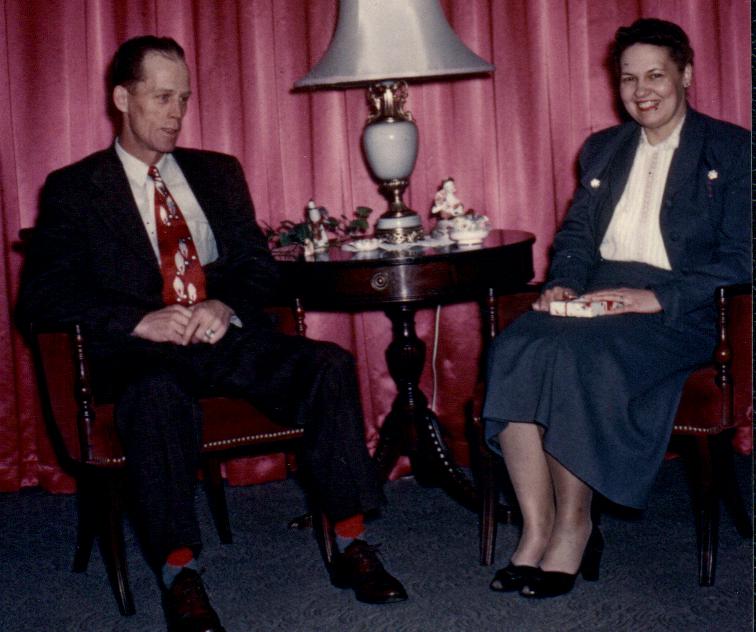
At his birth John’s family lived at 41 Aberdeen St. in Salt Lake City. The 1910 city directory shows the family living in Salt Lake City Ward 2 with his mother Ethel. By 1920 they were living in Salt Lake City moved to ward 5. John attended and played football for East High in Salt Lake City. By 1930 his father Josiah Walter had passed away and he was working as a clerk for Western Union.
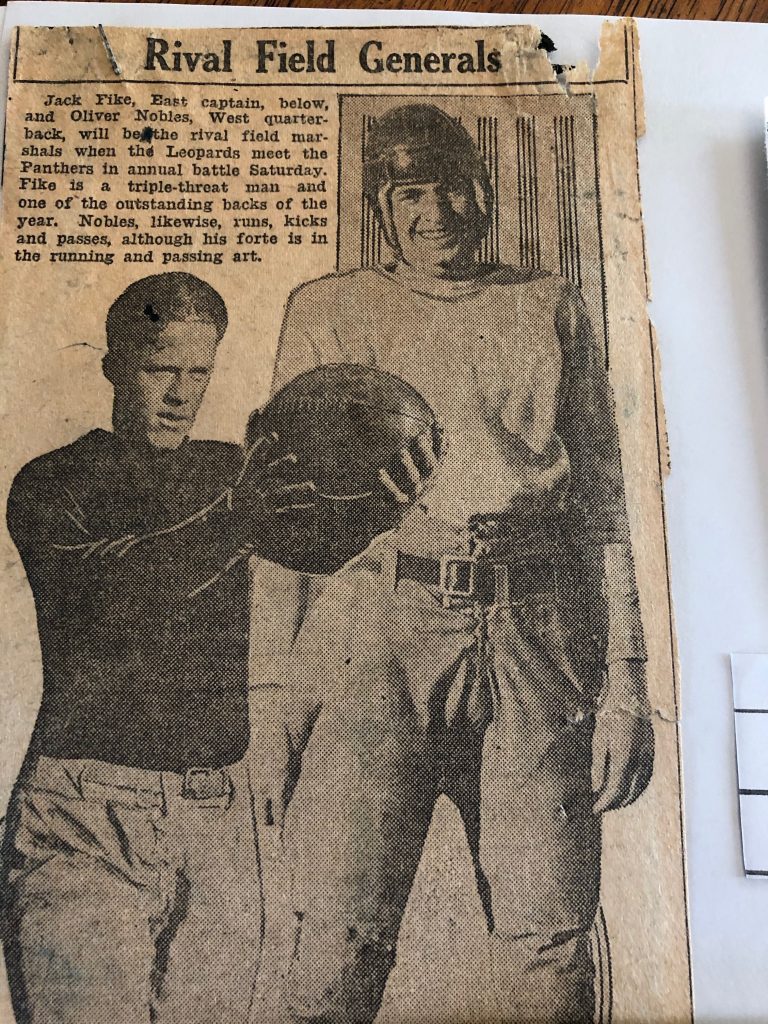
John married Elizabeth (Betty) Andrew in 1937 in Salt Lake City, Utah.
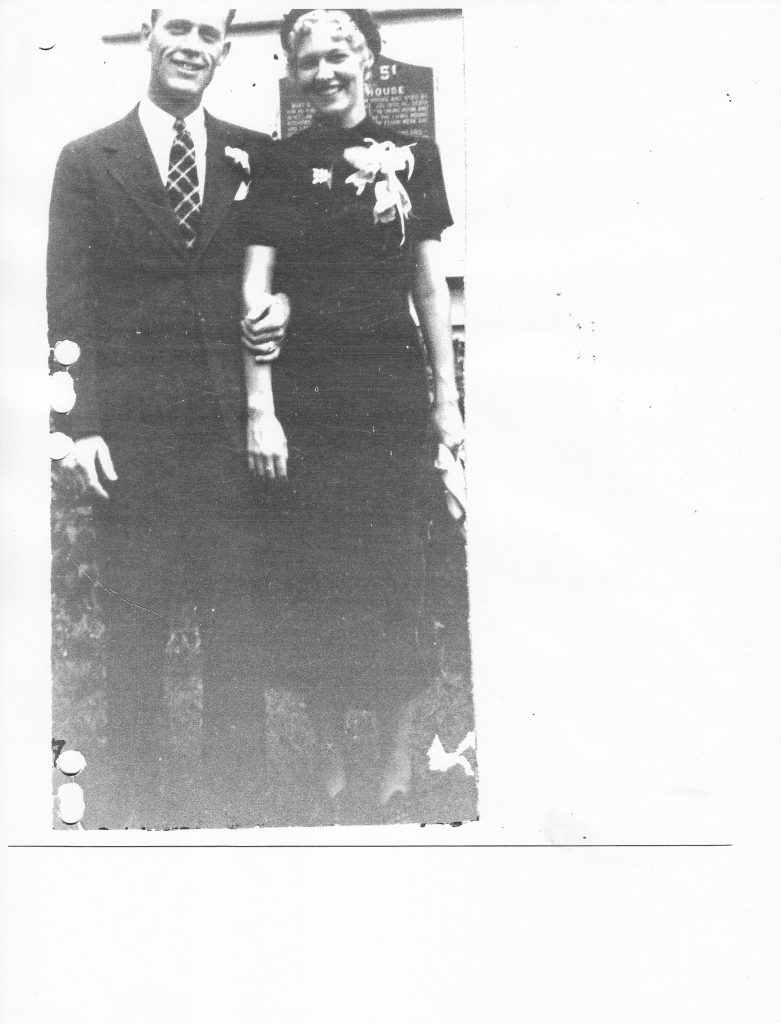
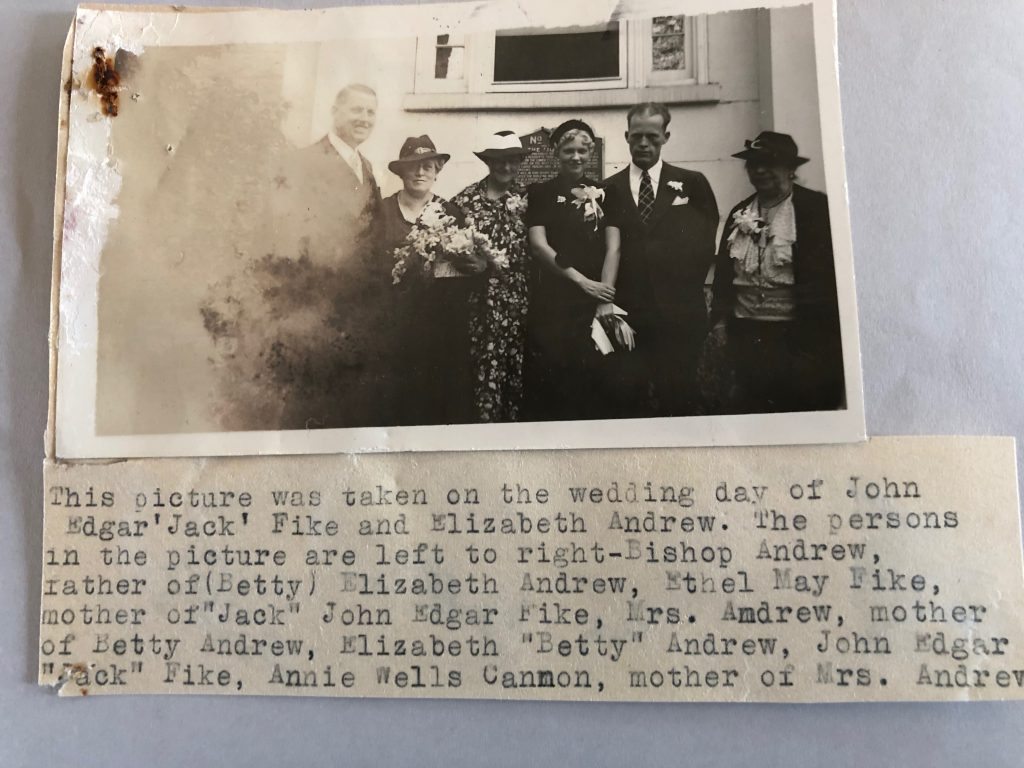
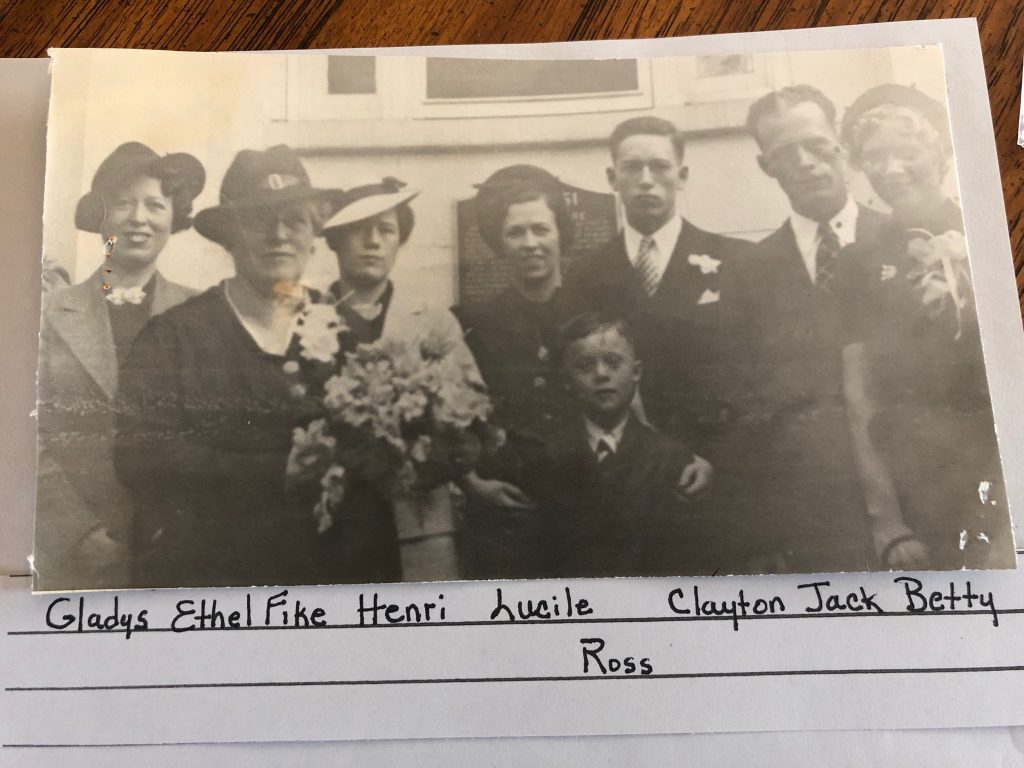
In 1939 Betty lived at 261 W. 4th South St. working as a clerk for company named EC&FL and by 1940 John was living in Las Vegas, Nevada at age 32 working as a collector for a farm implements company. At that time Betty and their first son, John E. Fike, Jr., were living with her parents in Salt Lake City. Her father was a bank teller, her mother a librarian, and Betty was a stenographer.
In 1941 John and Betty were living at 722 E. 3rd South #3 SLC with John working as a clerk at Sears and Betty as a secretary at EC&Fl.
By 1942 the family moved to Ogden and was living at 2610 Brinker Ave. John was a manager for Sears Roebuck. Between 1944 and 1956 they were still living at 2610 Brinker Ave. and John was a brakeman for the Union Pacific Railroad. He worked the trains eastbound from Ogden Union Station up the Weber valley to Green River. At Green River he would crew change and work the westbound back to Ogden.
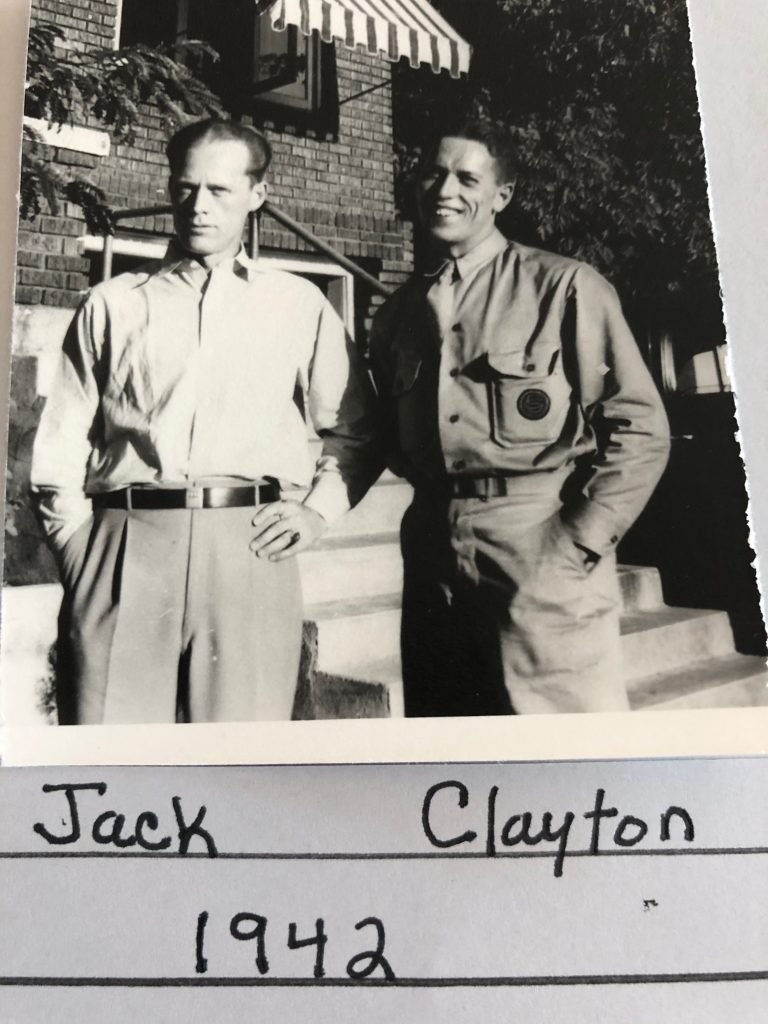
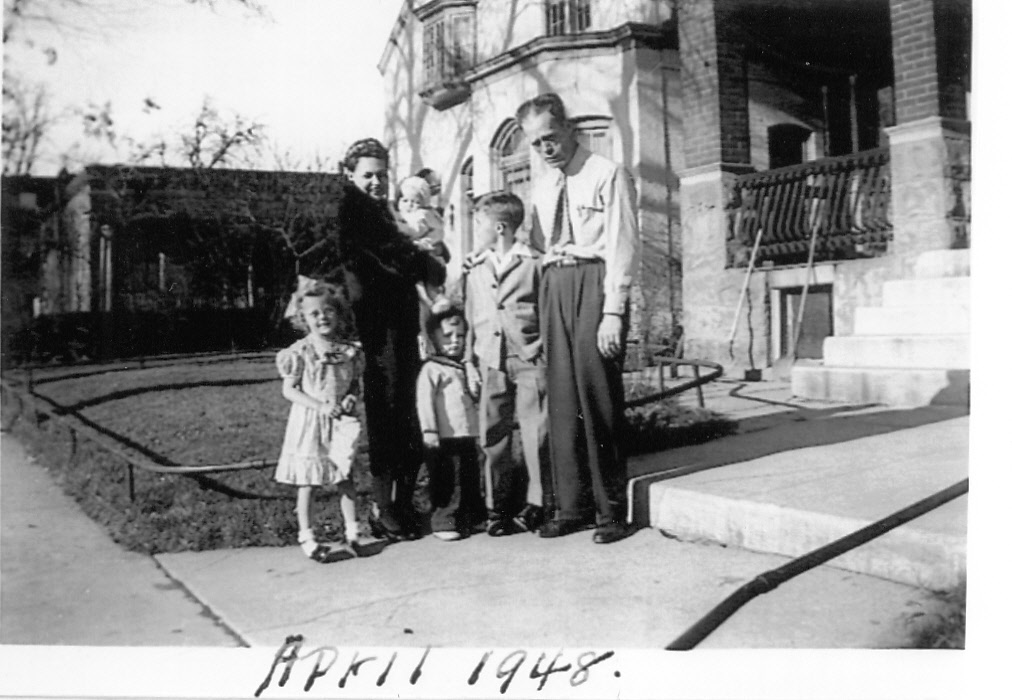
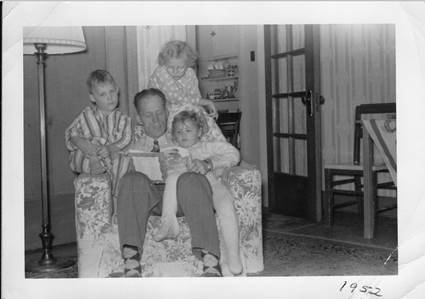
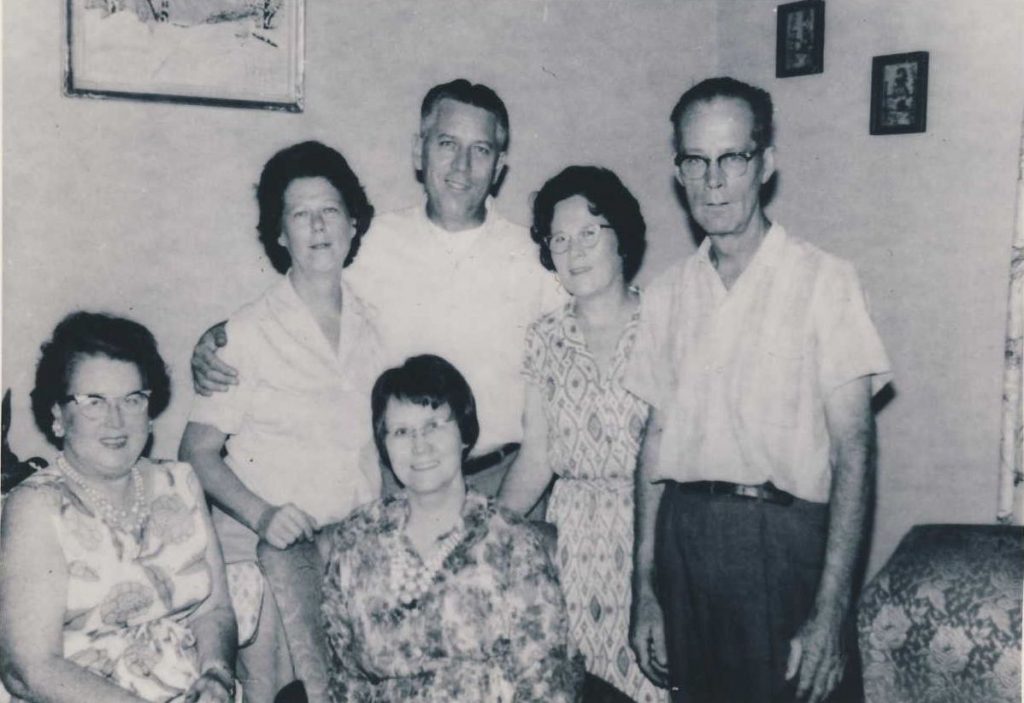
John passed away 20 January 1970.
FamilySearch ID – KWCL-QN4
Josiah Walter Fike
Josiah Walter Fike (1863-1924) Ethel May McMonegal (1876-1942)

Josiah Walter Fike was born March 31, 1863 in South Central Illinois. His namesake grandfather, Josiah Achem Fike, moved the family to Illinois in the early days of westward expansion. Josiah’s father, Thomas Lanman Fike, moved his family to Newton County, Missouri in 1867 and then to Tarkio, Missouri in the Northwest corner of the state in 1876.
Josiah Walter’s father was Thomas Lanman Fike, born 29 Sep 1834 in Morrison, Illinois and died 24 Sep 1910 in Grainfield, Kansas. On 03 Apr 1856 in Marion Co., Illinois. His mother was Frances Catherine Henry, born 11 Feb 1837 in Robertson Co., Tennessee and died 13 May 1883 in Atchison Co., Missouri.
The next public record of Josiah Walter was the 1885 the Nebraska state census that shows him living in Stewart Township, Holt Co., Nebraska at age 22 as a boarder and a farmer. He married Ethel McMonegal in Price, Utah in 1903. In that same year Josiah and Ethel were operating a hotel in Green River, Utah. By 1905 the family had moved to Salt Lake City and by 1907 they lived at 41 Harrison Ave. in Salt Lake City and he was working as a real estate broker. In 1908 they were at 41 Aberdeen St and by 1914 they lived at 341 American Ave.
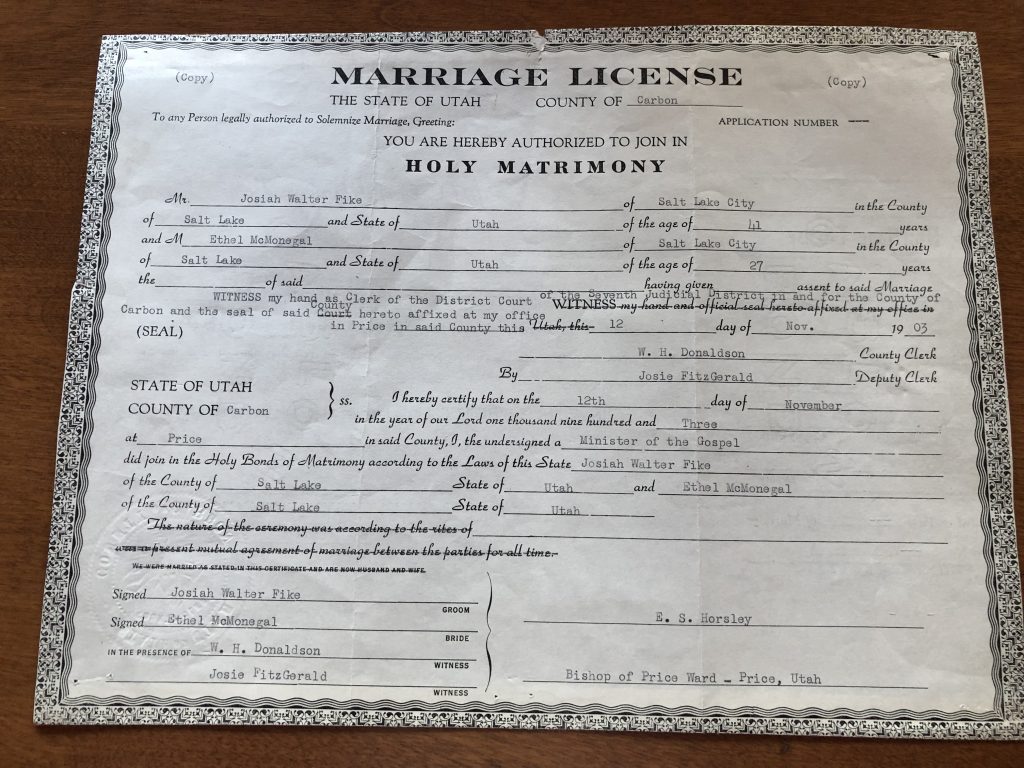
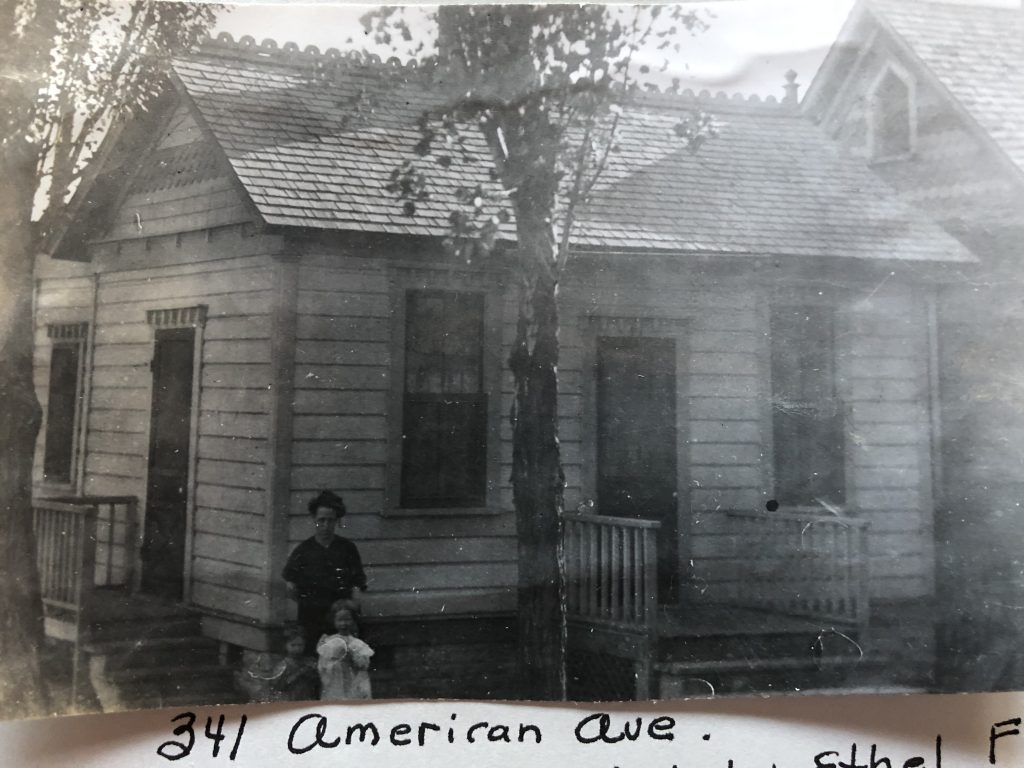
In 1915 they family sold their house on American Ave. to an adjacent Ice business and moved onto the Ute Indian Reservation on Blue Bench, Blue Mesa, near Duchesne, Utah. The photo above shows John Edgar and Ethel in front of the house.
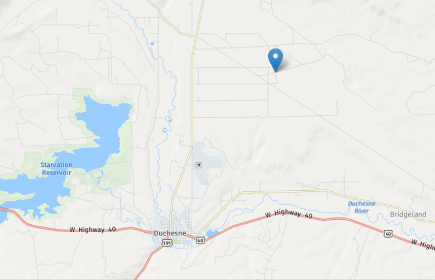
The map shows the location of Blue Bench, Utah – 6 miles North East of the town of Duchesne, Utah; about 70 miles due East of Provo, UT. Today it is 122 miles driving on modern roads (a two-hour car trip) from Salt Lake City. In 1915 It took the Fike’s two weeks to get there travelling in a wagon drawn by one horse and one mule.
“History of Blue Bench:
The settlement of Duchesne County is unique in Utah history, for unlike much of the state, it did not occur under the direction of Brigham Young or the Mormon Church. Rather, it was settled by individuals who obtained 160 acres under the federal Homestead Act. Homesteaders were required to prove that they intended to farm the land. After five years of living on the land, making improvements, and paying $1.25 per acre homesteaders were given title to their homesteads.”
Sometime before 1920 Ethel and the kids moved back to Salt Lake City so they could continue their educations. Josiah lived apart from the family. By 1920 Josiah was in Randlett, Uinta Co., Utah at age 57 living by himself and working as a farm laborer. He passed away in 1924 in Elberta, Utah (South of Provo). His body was returned to Tarkio, Missouri to be buried in the family plot with his parents.
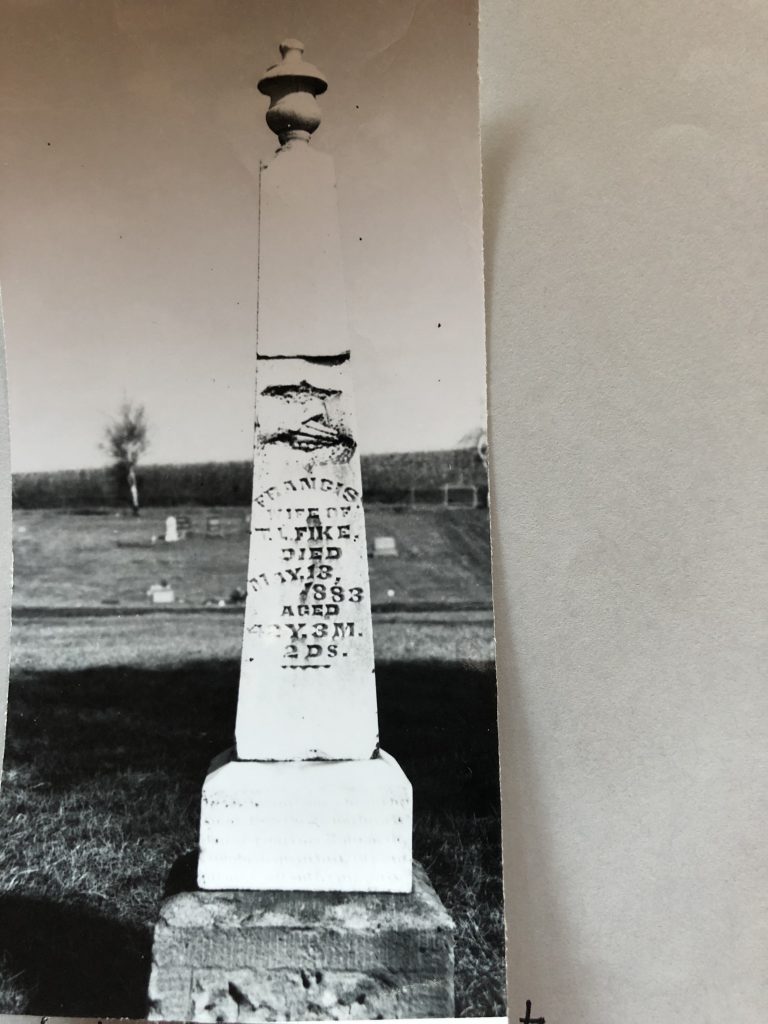
By the time of the 1920 census Ethel Fike was a 44 year old head of household living in Salt Lake City. She lived at 817 E. 2nd South street for the rest of her life. Her mother Henrietta Bellen moved in with her at this address at the end of her life. In 1930 Ethel was 54 with three children at home. Gladys and our ancestor John were both in their 20s and working. Gladys was employed as a seamstress, and Clayton was 12 years old at that time.
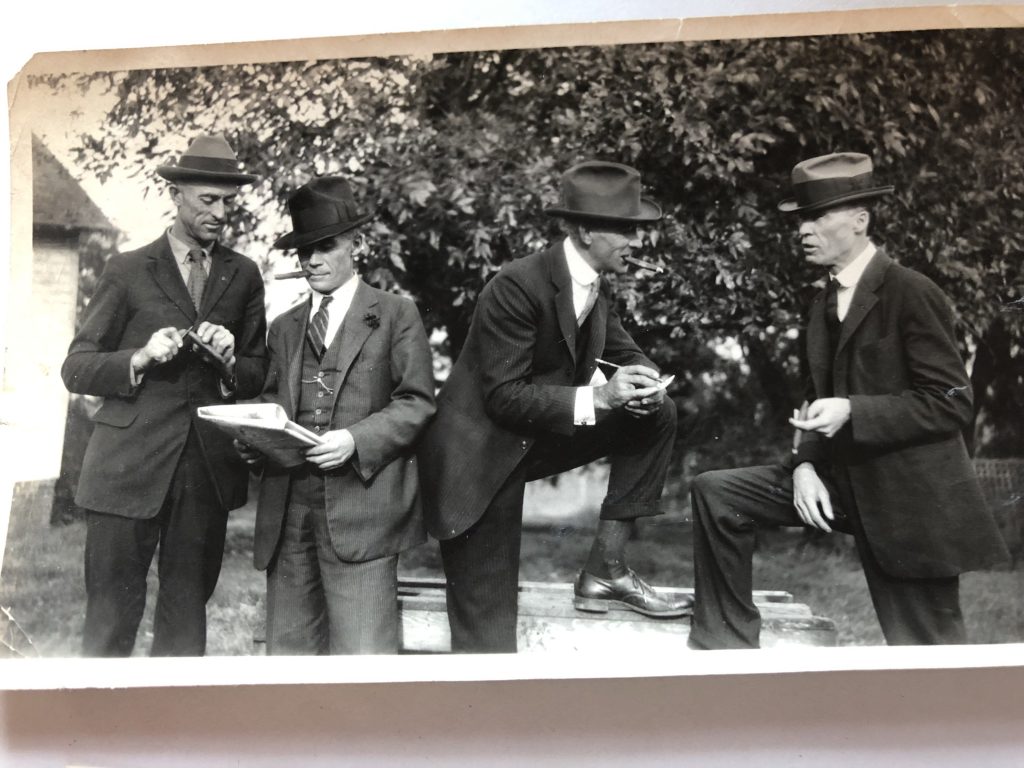
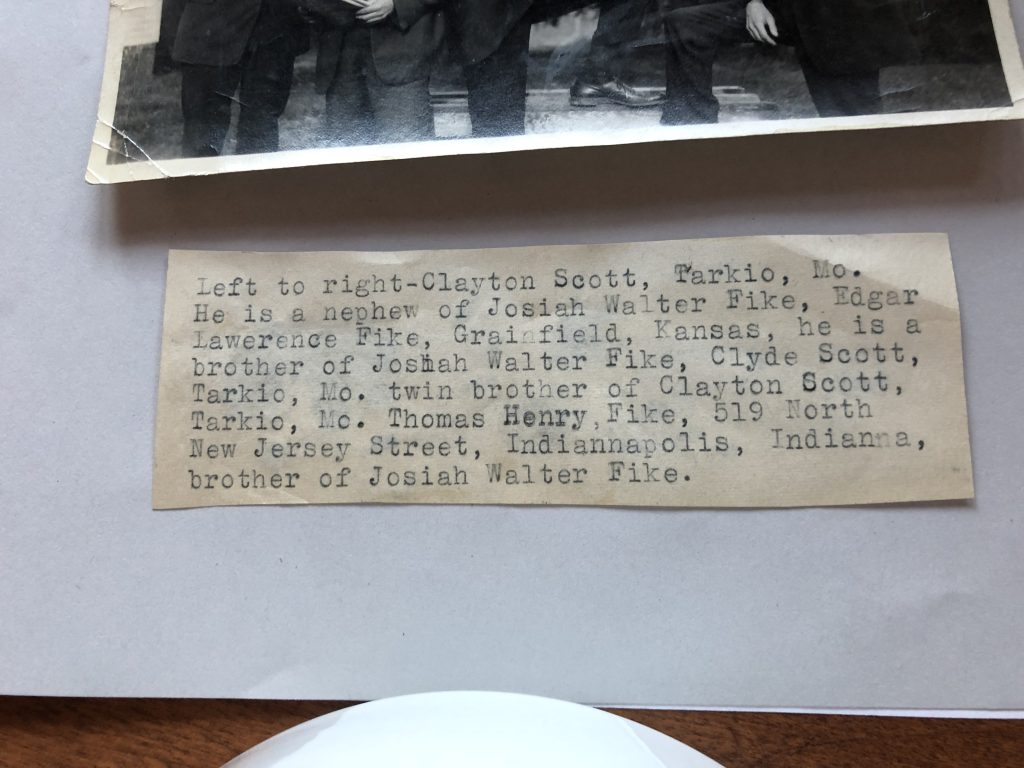
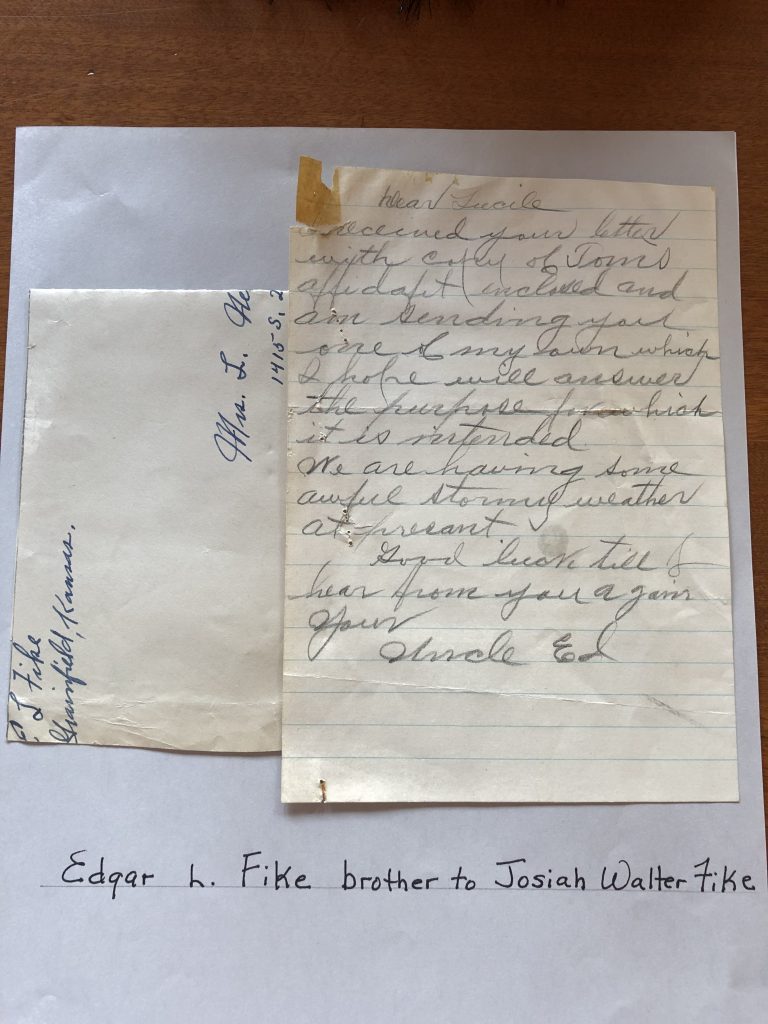
Below is Josiah Fike’s life story. I enjoyed reading the family letters below. They give us a sense of what life was like for our ancestors.

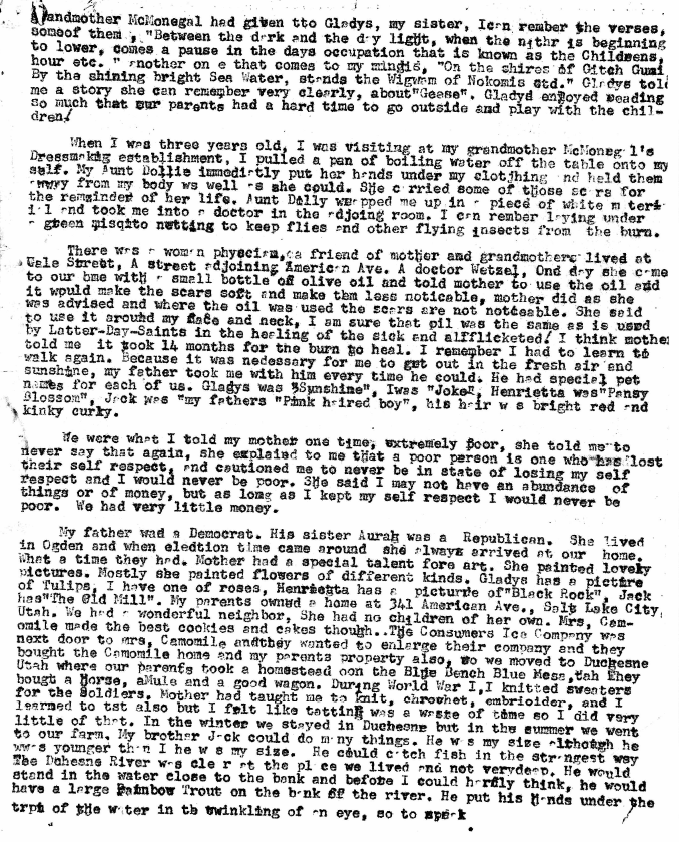
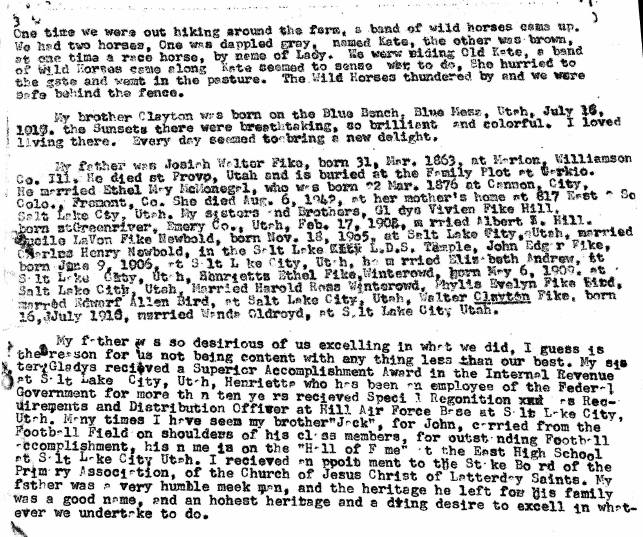
This letter is to Charlotte Fike Packard who was a cousin that Beth’s mother ran into in pursing genealogy. Charlotte’s father, James Allen Fike, and Josiah were cousins:
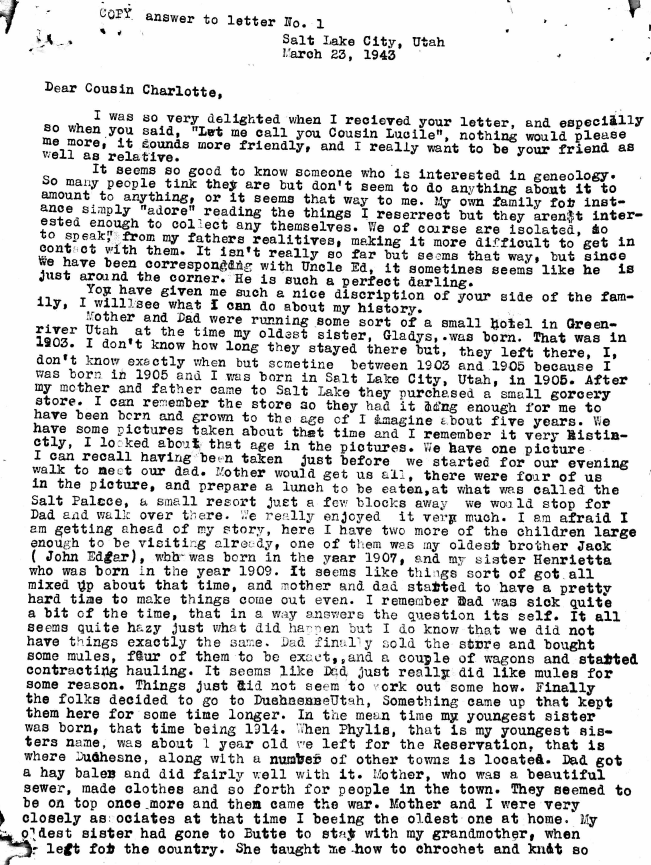
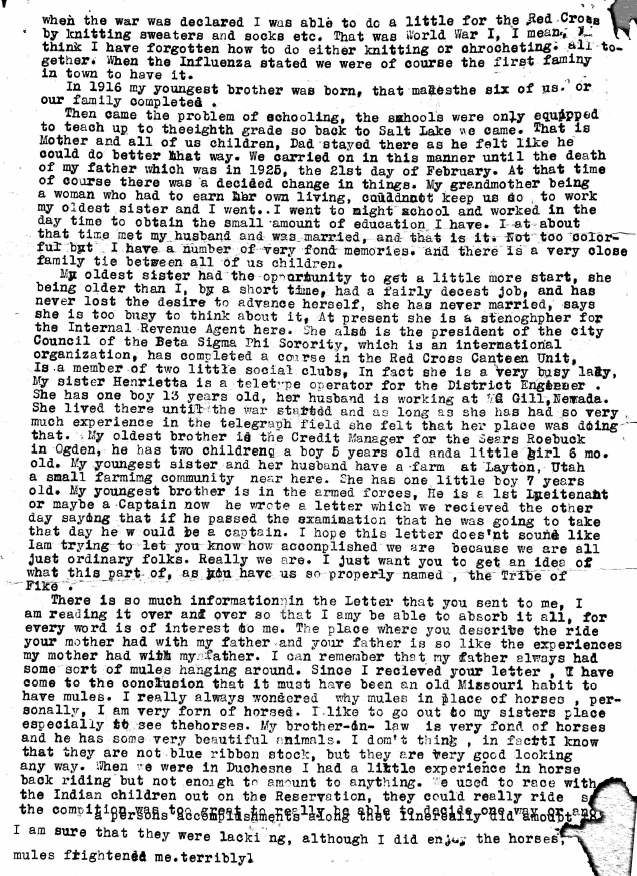
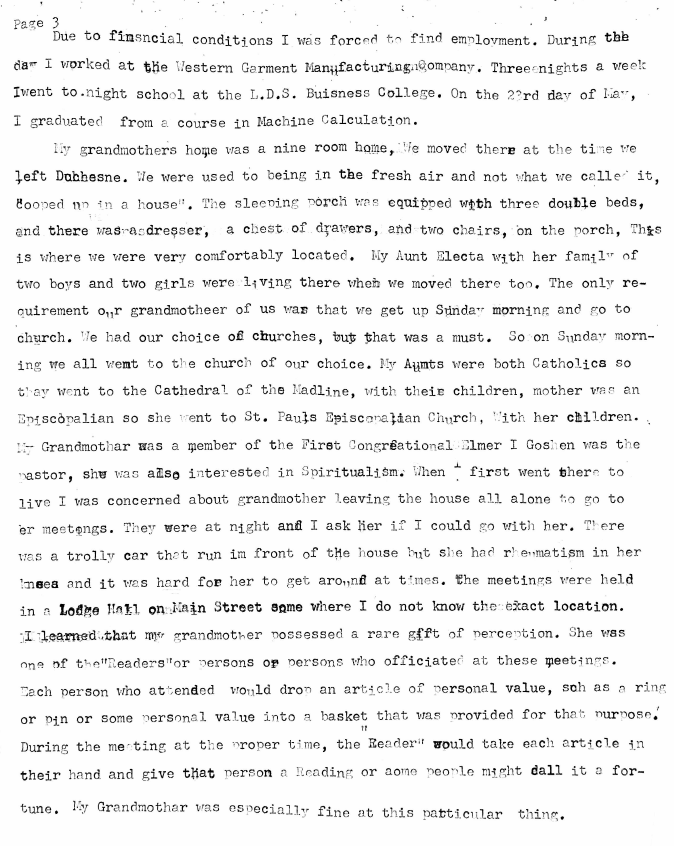
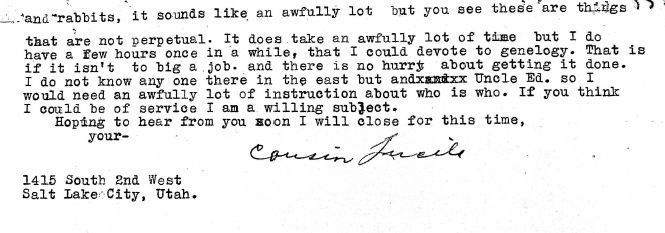
This is Lucile Fike Newbold’s Life Story:
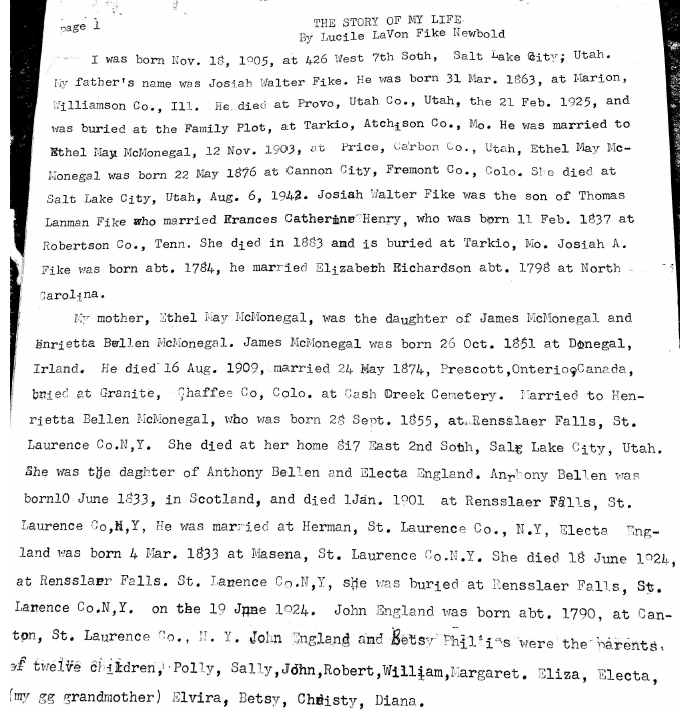
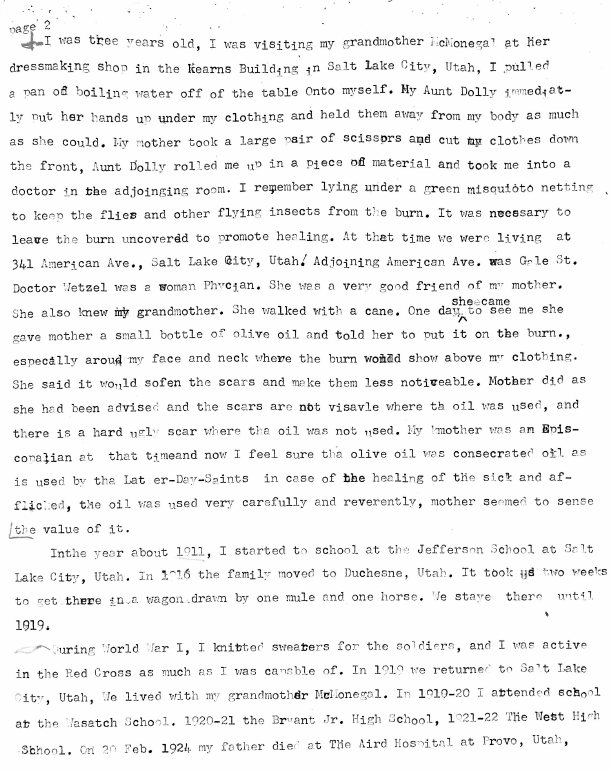
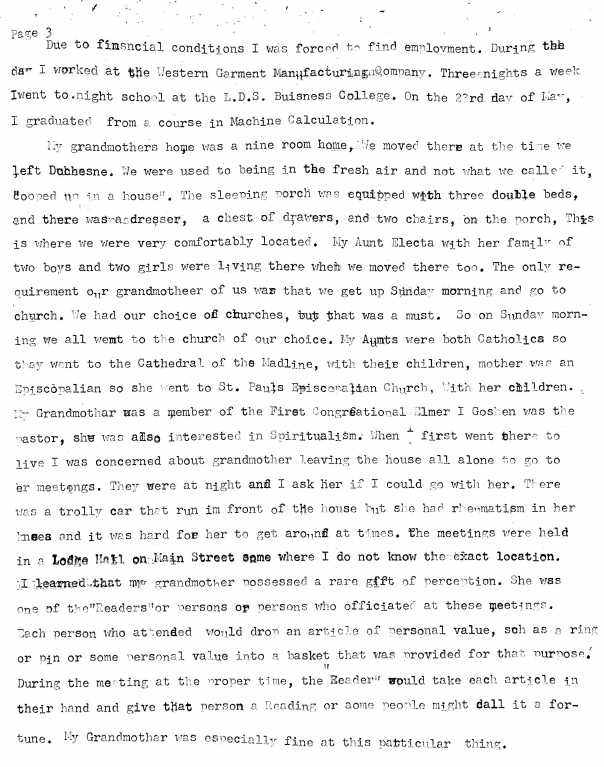
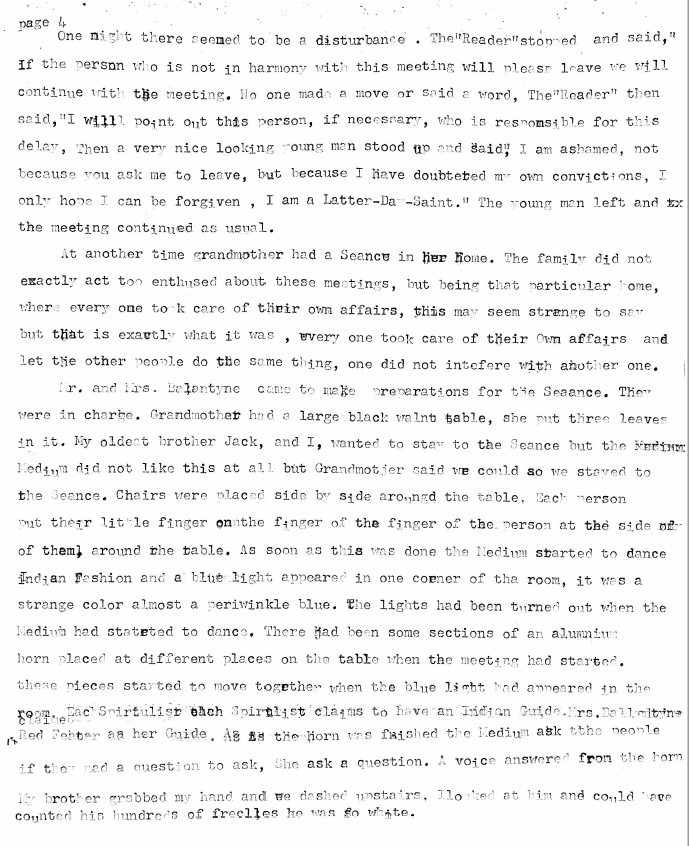
Josiah died in 1924 and his body was returned to Tarkio, Missouri to be buried in the family plot with his parents.
FamilySearch ID – 27WZ-Q9R
Ethel May McMonegal
Ethel May McMonegal was born on March 22, 1876, in Cañon City, Colorado, to James and Henrietta McMonegal. Her father James was making a living as a miner in the Colorado Rockies. For the rest of his life James worked as a miner. We can track their movements with the locations of his daughter’s births, city directories, personal letters, and census records.
1876 Their eldest daughter Ethel was born in Canon City, Colorado.
1877 Electa was born in Rocky Ford, Ontario Co. Colorado.
1878 Dolly was born in Leadville, Colorado.
1880 The Leadville City Directory shows them living at 826 E. 5th St. with James working as a miner.
1881 Living in Leadville at 826 E. 5th St. and James working as a miner.
1882 Living in Leadville at 325 East 3rd St. James working as a contractor.
1886 James and Henrietta divorced. In a letter James talks about leaving the family while they were living in Leadville.
The first record of Henrietta independent from James is an 1891 Denver City Directory showing Henrietta working as a dressmaker. Ethel attended Denver public schools. By 1902 Henrietta and the girls moved to Salt Lake City.
Ethel married Josiah Walter Fike on November 12, 1903, in Price, Utah. They had six children in 13 years.
By 1920 Ethel Fike was a 44-year-old head of household living in Salt Lake City. They lived at 817 E. 2nd South street in Salt Lake City for the rest of her life. Her mother Henrietta Bellen moved in with her at this address at the end of her life. In 1930 Ethel was 54 with three children at home. Gladys and our ancestor John were both in their 20s and working. Clayton was 12 years old at that time. Ethel was employed as a seamstress. Ethel died on August 6, 1942, in Salt Lake City, Utah, at the age of 66, and is interred at the City View Mortuary in Salt Lake City.

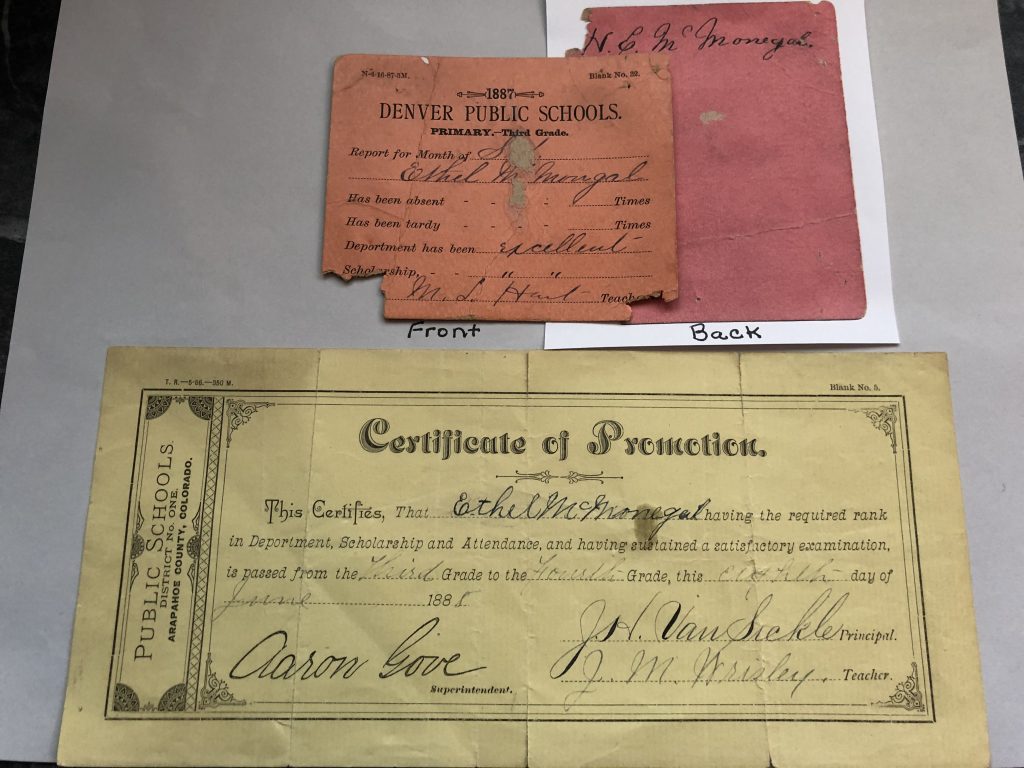
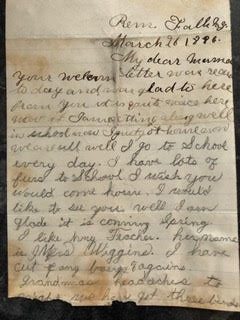
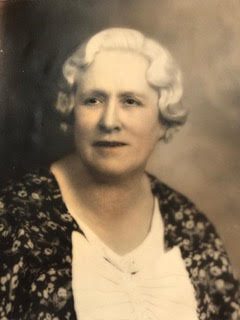
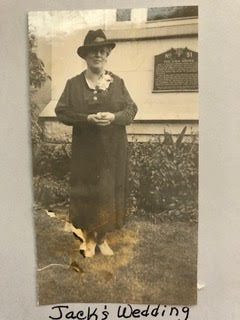
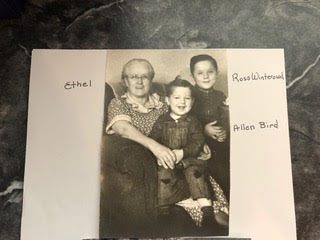
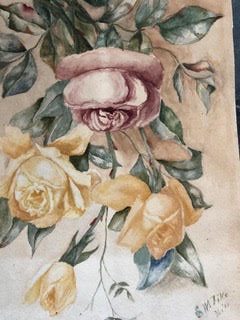

Family Search ID – KWCF-SCS
Thomas Lanman Fike and Frances Henry
Thomas Lanman Fike (1834-1910) Frances C. Henry (1837-1883)
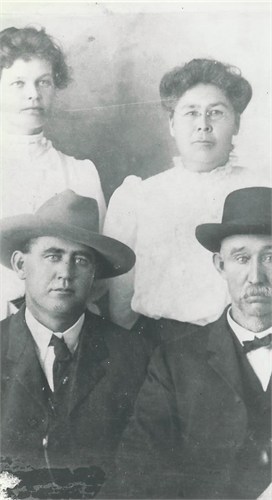
Thomas Lanman Fike was born to Josiah Achem Fyke and Elizabeth Richardson 29 September 1834 in Morrison, Illinois. He married Frances Henry 03 April 1859 in Marion County, Illinois.
Around 1827 the Fyke, Richardson, and Henry clans had moved from Central Tennessee, north of Nashville, to central Illinois as the frontier continued to move west and the children of the Revolutionary war generation sought their fortunes by clearing the forests and farming in the newly opened territories. Both his parents died by 1860. Thomas had four older brothers, so he was unlikely to inherit much land in Illinois. The couple moved to Newton County, Missouri in 1867 and then to Tarkio, Missouri in the Northwest corner of the state in 1876.
From “The History of Atchison and Holt County Missouri”: “Thomas L. Fike farmer & stock raiser in section 8- was born Sept. 29, 1834 in Morrison Co. Ill. His father Josiah Fike was born in Tenn. & his mother formerly Elizabeth Richardson was a native of North Carolina. The former was a sailor and took part in the war of 1812 and was at the noted battle of New Orleans.
Thomas was brought up on a farm and received an education in the neighborhood schools. In 1867 he moved to Newton Co. Missouri and settled on a farm where he remained nine years. In spring of 1876 he came to Atchison Co., Missouri where he now resides.
He owns 140 acres of fine land. Has a neat residence, good barn, orchard, etc. His place was one of the oldest in the township & in the early days was a stopping place for travelers between Rockport & the Nodaway River. Mr. Fike is a member of Atchison lodge No. 220 AOUW of Tarkio. He was married to Miss Frances Henry daughter of Thomas & Sarah Henry of Marion Co., Ill. She was born Feb 11th, 1837 in Robertson Co., Tennessee. They have 7 children. Nancy A born Jan 5, 1857 now (Mrs John Scott) of this County, Sarah E. born Jan 23, 1859, Lou Ellen born Apr 22, ? , Thomas H. born May 6, 1869, Josiah W.(Ancestor) born March 31, Arrah born Oct. 1, ? , Edgar L. born Mar 8, 1872. Mr. Fike and his wife are members of the Christian Church of Tarkio in which he holds the position of deacon.”
In 1850 and 1860 the census records show Thomas in Marion County, Illinois. By the 1880 census the family was in Tarkio, Missouri. In 1910 the census shows Thomas, age 74, his daughter Lizzie S., age 50, and son Edgar L., age 38, living in Grainfield, Kansas. It lists Thomas as a druggist and Edgar as a salesman for a general store.
On 03/14/2014 John E Fike, Jr. wrote this e-mail about a family history journey to the grave of Thomas Lanman Fike:
“As you know we’ve visited the “Fike” plots in a little country cemetery just south of Tarkio twice. I’ve talked with the sextant there also. The youngest son, Edgar is the source of my dad’s and my middle name. He never married and was an entertainer that traveled all around the country, according to articles we saw in the possession of a lady in Tarkio that had documented a lot of stuff about Tarkio. His head stone is there with an unmarked grave between it and Nancy Scott. Obviously, Nancy was the oldest daughter of Thomas and Elizabeth. There are a lot of Scott markers in the cemetery.
I’m pretty sure the unmarked grave (the sextant says there is a body buried there for sure) is that of my grandfather Josiah Walter. I always heard dad and mom talk about his name being Walter Josiah, but have no certificate to prove it. Aunt Lucille (dad’s older sister) had some information that said Josiah died somewhere around Provo, UT, and his body was shipped back to Tarkio to be buried. There is no marker or record of where Thomas L. is buried, but according to the sextant, he was the one who purchased the “Fike” plots.”
Frances Henry’s parents were Thomas Henry and Sarah Stark. You can follow this link to learn about the Stark and Henry families. They were instrumental in the settling of Tennessee after the revolution. Frances was the second great-granddaughter of Colonel John Donelson, a war hero and pioneer of the westward expansion across the Alleghenies. His daughter Rachel married President Andrew Jackson. John and his wife Rachel are buried at the church cemetery at the entrance to Jackson’s plantation, The Hermitage, near Nashville, Tennessee.
Thomas FamilySearch ID – KPWX-NVT, Frances L7BF-BK1
James McMonegal
James McMonegal (1841-1909)

My 2nd great-grandfather James McMonegal was born in County Donegal, Ireland in 1841. His father was James McMonegal, born in County Donegal in 1815. We don’t know his mothers name but her birthplace was listed as Scotland on James’ death certificate. He was a child during the Irish Potato Famine which was at its peak from 1845-1849. It is likely that the famine and other hardships in Ireland led James to emigrate to America. It’s possible that the 1860 Census shows him living in Canton, New York.
The census shows a Jas Mack age 21 living with James McMonegal age 39 at dwelling 139 in Canton, New York; both born in Ireland. Jas Mack could be my 2nd great-grandfather James McMonegal whose death certificate lists his birthdate as 6 October 1841. The birth dates are off by 2 years. James, age 39, could possibly be my James’ father (18 – 20 year age difference) or he could be a brother or cousin.

There are two other facts details that add credibility to this theory:
- Canton NY is 18 miles from Ogdensburg where James enlisted in the Army the next year.
2. The previous page of the census report lists James’ future wife and family living at dwelling 119, only a few houses away in the same town.

James enlisted in The New York 60th Regiment Company A on 6 September 1861 in Ogdensburg, New York. He served the Union army with distinction for the duration of the Civil War. The 60th New York fought at both Antietam in 1862 and Gettysburg in 1863. The 60th has a monument on the Gettysburg battlefield.
In 1864 re-enlisted into the Company B of the 1st Engineering Battalion. The Engineers were involved in the siege of Petersburgh from June 1864 to April 1865. After the Union army prevailed at Richmond the 1st Engineers were present at the surrender of Lee’s Army at Appomattox in April of 1865. He was discharged from the army February 5th 1867 at Brandy Station.
Click here to read about James McMonegal’s experiences during the Civil War
James McMonegal in the Civil War:
This regiment, the 1st St. Lawrence regiment, was organized at Ogdensburg, NY and there mustered into the U. S. service for three years, on Oct. 30, 1861. It left for Washington on Nov. 4 and was stationed in that vicinity during the winter and was in Gen. Dix’s railroad brigade in the spring of 1862.
In June 1862, the regiment was attached to the 2nd brigade, of Sigel’s division, Department of the Shenandoah and later to the 3d brigade, 2nd division, 2nd corps, Army of Virginia. It participated in Gen. Pope’s Virginia campaign and on Sept. 12, was attached, with its brigade and division, to the 12th corps.
On September 16 and 17, 1862 they fought at the battle of Antietam where Col. Goodrich, commanding the brigade, was killed and the regiment lost 22 in killed, wounded and missing.
Antietam after battle report: Report of Lieut. Col. Charles R. Brundage, Sixtieth New York Infantry of the battle of Antietam. HDQRS. SIXTIETH NEW YORK STATE VOLUNTEERS, Camp on Loudoun Heights, Va., September 27, 1862. “I have the honor to report that, on the morning of the 17th of September 1862, the Sixtieth Regiment New York State Volunteers went into action with 217 enlisted men and 9 commissioned officers, and that with his company (Company C) to skirmish, which he did with admirable skill and effect, clearing the woods to the right of the enemy’s sharpshooters. After being in action between two and three hours, a brigade fell back on us, breaking our line and scattering our men, making a delay of an hour or more in our rejoining our brigade, then formed in line about half a mile to the rear of their position in action. The regiment remained with the brigade during the remainder of the day and moved with it at dark to rejoin the division. I take pleasure in reporting that the officers and men behaved well under fire, promptly obeying all orders. For an account of our losses, I beg leave to refer you to the official report of casualties. Very respectfully submitted. CHAS. R. BRUNDAGE, Lieut.-Col., Sixtieth New York State Volunteers. Col. W. O. REDDEN, Commanding Third Brigade.
In October it was assigned to the 2nd brigade, 2nd division of the 12th corps, posted at Harper’s Ferry until December, and then went into winter quarters at Stafford Court House, Va.
On May 1-3, 1863, at Chancellorsville, VA. the 12th corps led the advance and the loss of the 60th regiment was 66.
On Jul 2-3, 1863, the 60th fought at the battle of Gettysburg, PA. in the defense of Culp’s hill.
Gettysburg after battle report: Report of Col. Abel Godard, Sixtieth New York Infantry. Near Gettysburg, Pa., July 4, 1863. Capt.: “Herewith I have the honor to report that the situation and condition of the Sixtieth Regt. New York Volunteers, under my command at the battle of Gettysburg, Pa., July 2 and 3, were as follows, to wit: On July 2, at or about 6 a. m., the regiment with the brigade assumed position in line of battle, connecting with the right of the First Army Corps, where my command threw up intrenchments, by order of Gen. Greene, in person commanding Third Brigade. The men of the regiment worked with a will until about 9 a. m., by that time completing the intrenchments, which commanded on the left and center of the regiment the brow of a precipitous hill, and on the right extending to low ground. This line of intrenchments was about 1 mile from the enemy’s front, as I estimated the distance. Our works connected on the right with those of the One hundred and second New York Volunteers of our brigade.
From 9 a. m. to 4 p. m., or thereabouts, my men lay quietly behind our line of arms in the rear of our works. In the meanwhile, Gen. Greene passed frequently, inspecting the works. At about 4 p. m. Gen. Geary, commanding our division, espying the enemy in line, apparently a brigade, in force on my left, placed in position four guns, one in my line, whose firing scattered the enemy from our view. During the half hour’s firing of the gun in our line, the gunners, being wounded, were replaced by men from my regiment who were acquainted with artillery practice. The gun was removed before 5 p. m., and the line of the regiment was quiet until about 7 p. m., when the enemy’s infantry advanced in force, our skirmishers falling back within our line, and we opened a fire upon the enemy’s line, which continued along our whole line at close range, with, as was afterward discovered, terrible effect for about two hours, when, the firing of the enemy being nearly silenced, I ordered an advance of a portion of our regiment, who eagerly leaped the works and surrounded about 50 of the enemy, among whom were 2 officers, and took at the time two flags, one a brigade color and the other a regimental banner. At the receipt of these flags, a quiet enthusiasm pervaded the men and officers of the regiment.
After the opening of the infantry fire, an order was received from Gen. Greene that I must hold the works under all circumstances. I sent frequently for ammunition, which was promptly furnished, the right being out of ammunition but one time, when, by my order, bayonets were fixed, and thus remained until their boxes were replenished. All the commands were received by the men coolly, and instantly obeyed, more especially the orders “commence firing” and “cease firing.” During this time 9 men were killed and 16 wounded.
There was occasional firing by our regimental line until the break of day, July 3, when, with the exception of a reply to rebel sharpshooters, the firing ceased. We could then see large numbers of the enemy’s dead within less than 50 feet of our line. My men numbered 255 and 16 line officers, 1 adjutant, 1 field officer (Lieut.-Col. Redington on July 2 being brigade officer of the day, but after the picket and skirmishers came in did not report to me during the engagement, only being at the rear of the regiment late in the morning of the 3d).
The light firing above mentioned continued until a repeated advance of the enemy’s infantry at about 4 a. m. July 3, when heavy firing opened on both sides, and continued until 9.30 a. m., the enemy being steadily held in check, at which time they retired, leaving only sharpshooters, who kept up interval firing until about 2 p. m., when my men being much exhausted, the Sixtieth were relieved for one hour, retiring from and returning to the intrenchments under a sharp fire of sharpshooters. During the morning we sustained a loss of 2 men killed and 19 wounded, in addition to 2 lieutenants, one slightly, the other severely, wounded.
Our men resumed their places behind the works about one hour after being first relieved, and then remained until 2 a. m. July 4, meanwhile there being no firing. Too much praise cannot be awarded the regiment for its coolness and perfect obedience to orders. Officers and men are alike entitled to a proud reputation for efficient service in defending the hill on which they were situated, it being a most commanding position on the left of the Twelfth Corps.
The colors above named captured by the regiment have been forwarded to brigade headquarters, thence to be sent to the proper department. The proper record of capture is inscribed upon them. A full and complete list of killed, wounded, and missing has already been forwarded to brigade headquarters.* This supplementary report is most respectfully submitted. ABEL GODARD, Col., Comdg. Sixtieth New York Volunteers.” Capt. C. P. Horton, A. A. G., Third Brig., Second Div., Twelfth Army Corps.
Report of Lieut. Col. John C. O. Redington, Sixtieth New York Infantry. Camp near Littlestown, Pa., July 6, 1863. Capt.:
“I have the honor to report the action of the brigade skirmishers at Gettysburg on July 2. We relieved about 8 a. m. two companies of the Seventh Indiana, of the First Corps, my force consisting of 7 officers and 170 men, with which I covered the entire front of the Second Division. We advanced beyond the brook, and held our line until the advance of the line of battle of the enemy, about 7 p. m. During the day scouts were sent out in front of the line of skirmishers, and information obtained. About 4 p. m. the enemy planted a battery on a hill opposite the left of our line.
I sent forward about 25 sharpshooters, who opened a brisk fire on the cannoneers. A fire from Knap’s battery was also opened upon it. Under both fires the position was soon evacuated. The enemy four times advanced their skirmishers (once or twice in a double line), but our skirmishers drove them back. At about 7 p. m. they began the advance with their line of battle. I immediately withdrew my line to this side of the brook and threw forward every man of my reserve. We held this point with the briskest fire we could concentrate. Their line of battle was seen to lie down in the grass. We fell back as slowly as possible, the men under my command behaving in a truly splendid manner. Many had never drilled in skirmish tactics.
I desired to hold a line about 100 yards this side of the brook and sweep them as they crossed the brook. I sent back to the commander of the Twenty-eighth Pennsylvania, which had been sent out as a reserve, asking him to move up to that line. He returned answer that he had been ordered to return to the intrenchments. I therefore fell back slowly with my 170 men, contesting every inch of ground, the enemy close on to our heels and firing occasional volleys at us. The darkness was so great in this part of the woods that we could not see the enemy, and we fired at the flashes of their guns. They were so close to us that we took 12 prisoners. When within 50 yards of the works, I ordered the line to fall back into the earthworks. It was a half hour by the watch from the time that the enemy’s line of battle started when my line of skirmishers entered our works. I regret to have to report that a portion of the line in the trenches commenced firing before our skirmishers had come in, killing and wounding several. Our loss from the enemy’s fire was very small, so perfect was our concealment.
I desire to mention for his conspicuously gallant conduct the name of Private Peter Fifer, of Company B, One hundred and second New York. Respectfully, your obedient servant, JOHN C. O. REDINGTON, Lieut. Col. Sixtieth New York Vols.”
Moving southward with the army as far as the Rappahannock, the 60th regiment received orders to join the forces in the West and arrived at Bridgeport, Ala., the first week in October. The 60th was present at the battle of Wauhatchie, Tenn., and in the Chattanooga campaign.
Fought on 20 Sep 1863 at Chickamauga, GA.
Fought on 24 Nov 1863 at Lookout Mountain, TN.
Fought on 27 Nov 1863 at Ringgold, GA.
James was discharged from the New York 60th Feb. 5, 1864, and reenlisted at Brandy Station, Virginia as an officer in the New York 1st Battalion Engineer Regiment Company B, “Serrell’s Engineers”.
James joined the regiment at Port Royal, South Carolina, where it served in the 10th corps, Department of the South. In 1864 they took part in the bombardment of Olustee, Fla., and Morris Island. Its heaviest casualties during this period were at Morris Island, where it lost twenty-five killed and wounded,
Fought on 20 Feb 1864 at Olustee, FL.
Fought on 22 Feb 1864 at Morris Island, SC.
Fought on 27 Jun 1864 at Segaville, SC.
From May 1864, Cos. B (McMonegal’s company), D, E, F, H, K, L and M served with the Army of the James. In the operations against Petersburg and Richmond in May 1864, its services were particularly valuable at Bermuda Hundred, as also during the siege of Petersburg, where the regiment sustained a loss of nineteen in killed and wounded.
Fought on 29 Jun 1864 at Reams’ Station, VA.
Fought on 2 – 5 Aug 1864 at Petersburg, VA.
Fought on 13 Aug 1864 at Dutch Gap, VA.
Fought on 4 Sep 1864 at Petersburg, VA.
Fought on 2 Oct 1864 at Fort Harrison, VA.
Fought on 6 Dec 1864 at Devaux’s Neck.
Fought on 24 Jan 1865 at Fort Brady, VA.
The last active service of the regiment was in the final assault on Petersburg, April 2, 1865. (Lee’s surrender at Appomattox April 9, 1865). It was mustered out at Richmond, Va., June 30, 1865.

Between his Army discharge in 1867 and 1870 he was living in Golden City in the Colorado Territory just West of Denver working as a teamster and living in a boarding house with three other men.
In 1874 James returned to the St, Lawrence river valley and married Henrietta Bellen in Prescott, Ontario, Canada on 26 May 1874..
After their marriage James and Henrietta returned to Colorado and their eldest daughter, our ancestor Ethel, was born in Canon City, Colorado in 1876.
For the rest of his life James lived and worked as a miner in the Rocky Mountains. We can track his movements with the locations of his daughter’s birth, city directories, personal letters, and census records.
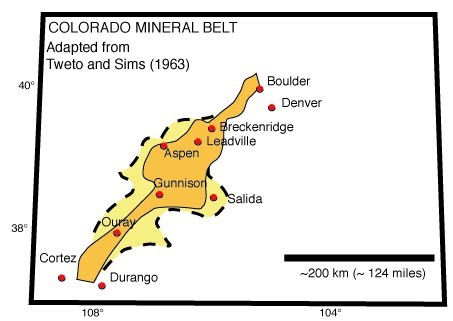
1877 Electa was born in Rocky Ford, Ontario Co. Colorado
1878 Dolly was born in Leadville, Colorado
1880 the Leadville City Directory shows them living at 826 E. 5th St. and working as a miner
1881 In Leadville living at 826 E. 5th St. and working as a miner
1882 In Leadville living at 325 East 3rd St. working as a contractor
1866 James and Henrietta divorced. In a letter James talks about leaving the family while they were living in Leadville. The first record of Henrietta independent from James is an 1891 Denver City Directory showing Henrietta working as a dressmaker. By 1902 Henrietta and the girls moved to Salt Lake City.
1893 James writes a letter from San Juan County, Utah, 15 miles from Moab
1899 James writes his daughters from Granite, Colorado
1905 A letter from Salida County, Colorado
1907 Still in Salida working as a miner
1909 James died on August 19 and is buried in the Granite Cemetery in Granite, Colorado. His grave is not marked.
James’ FamilySearch ID – KCTD-YVJ

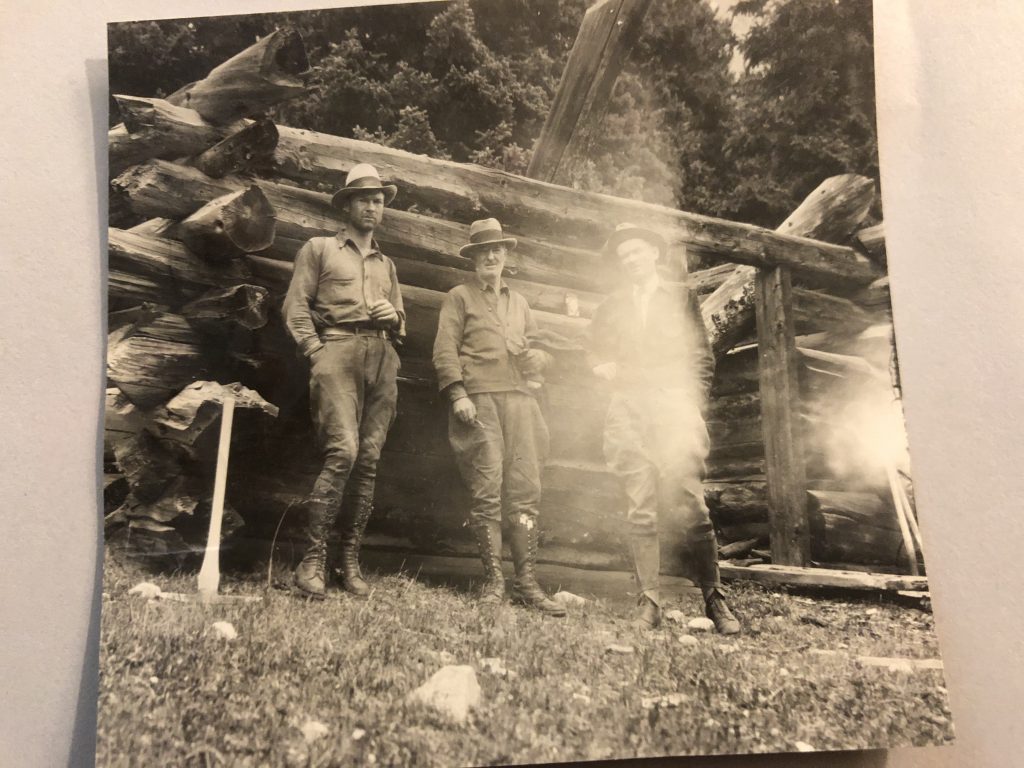
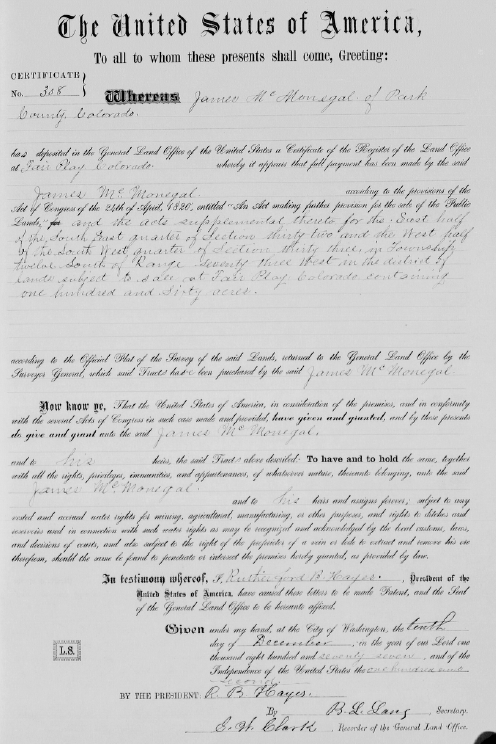
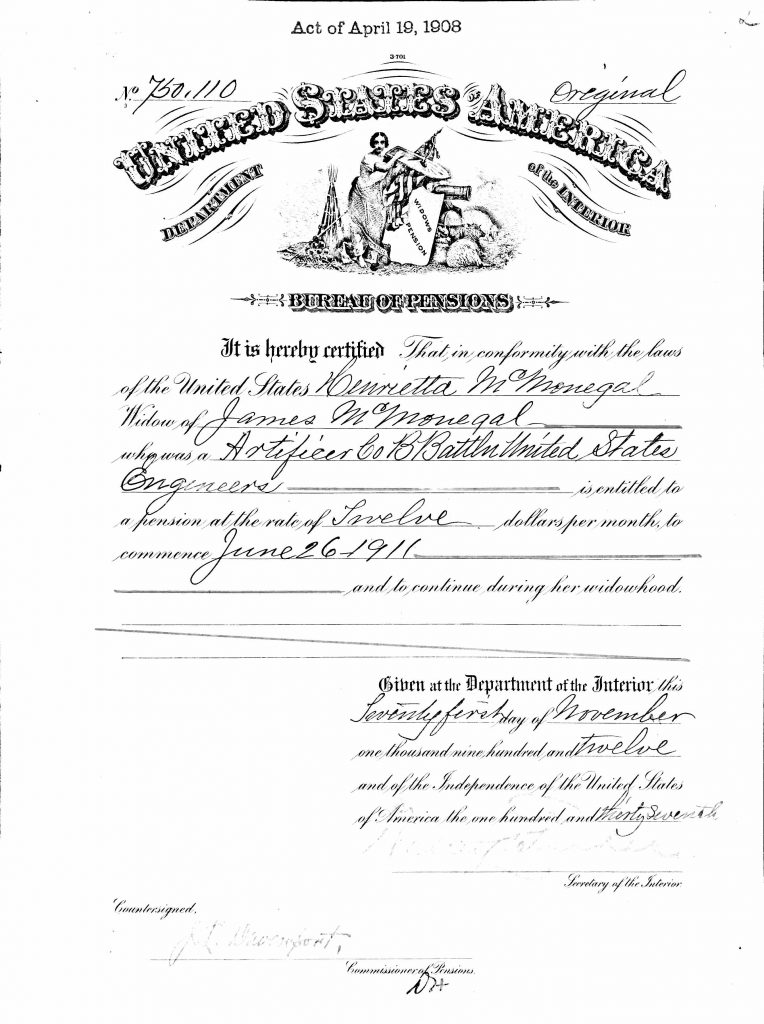
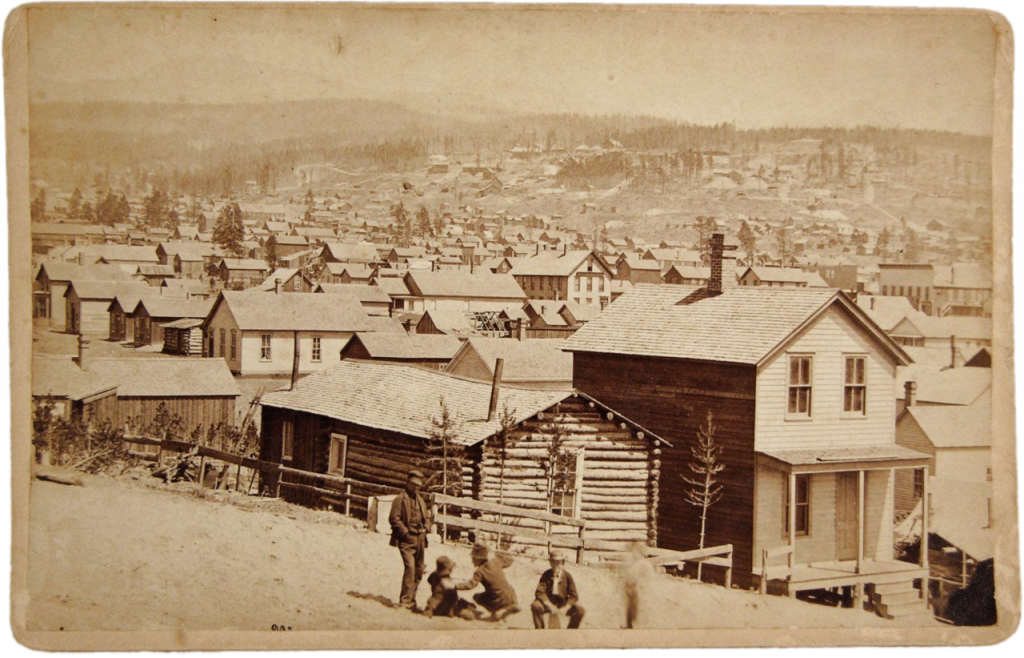
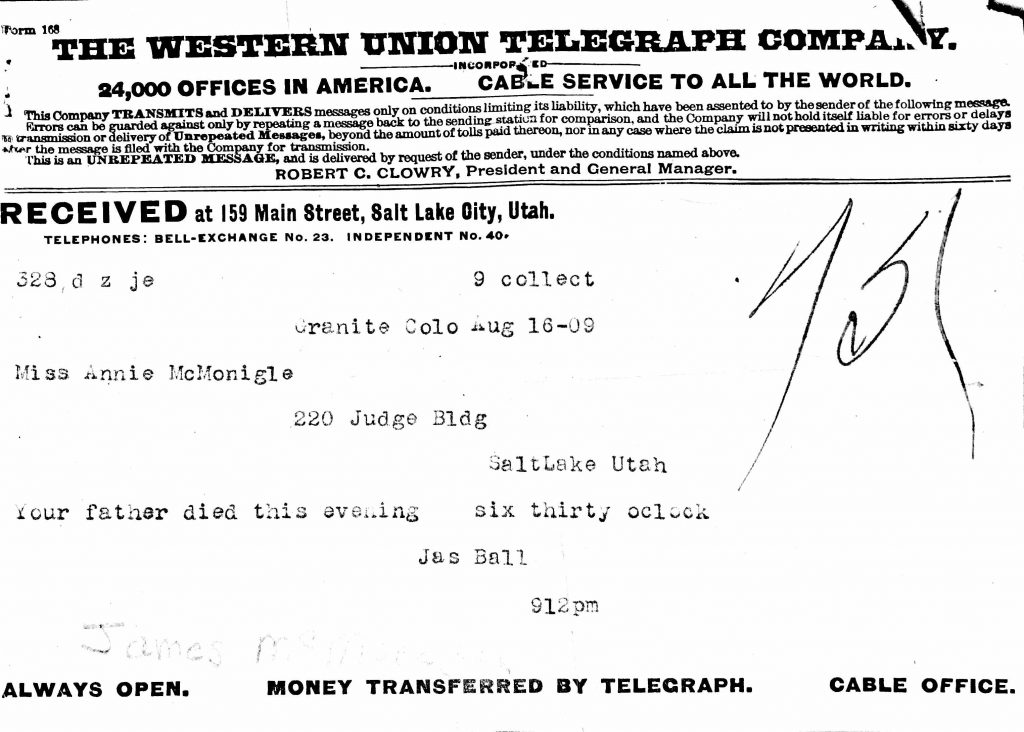
Images of James’ letters to his daughters
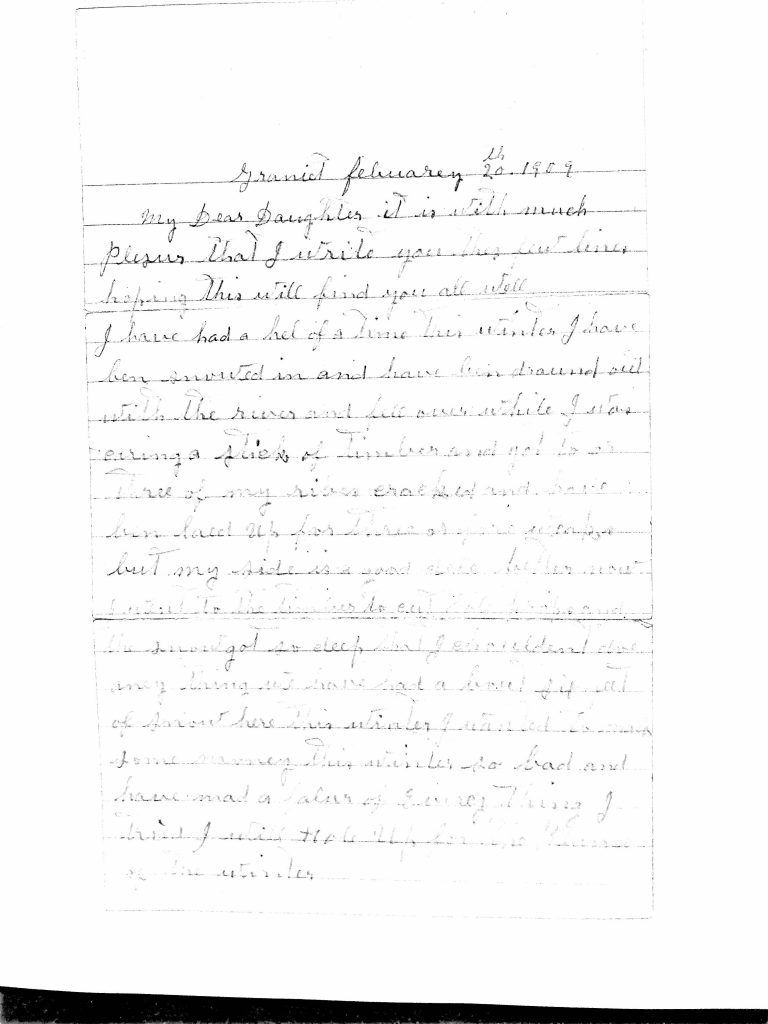
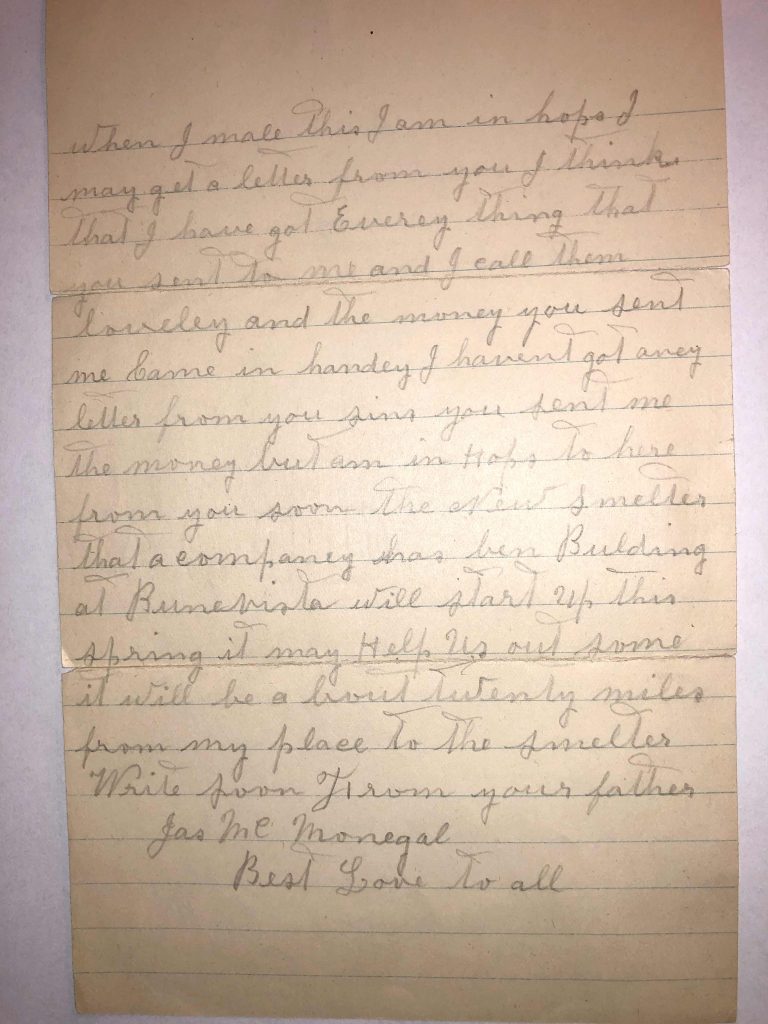
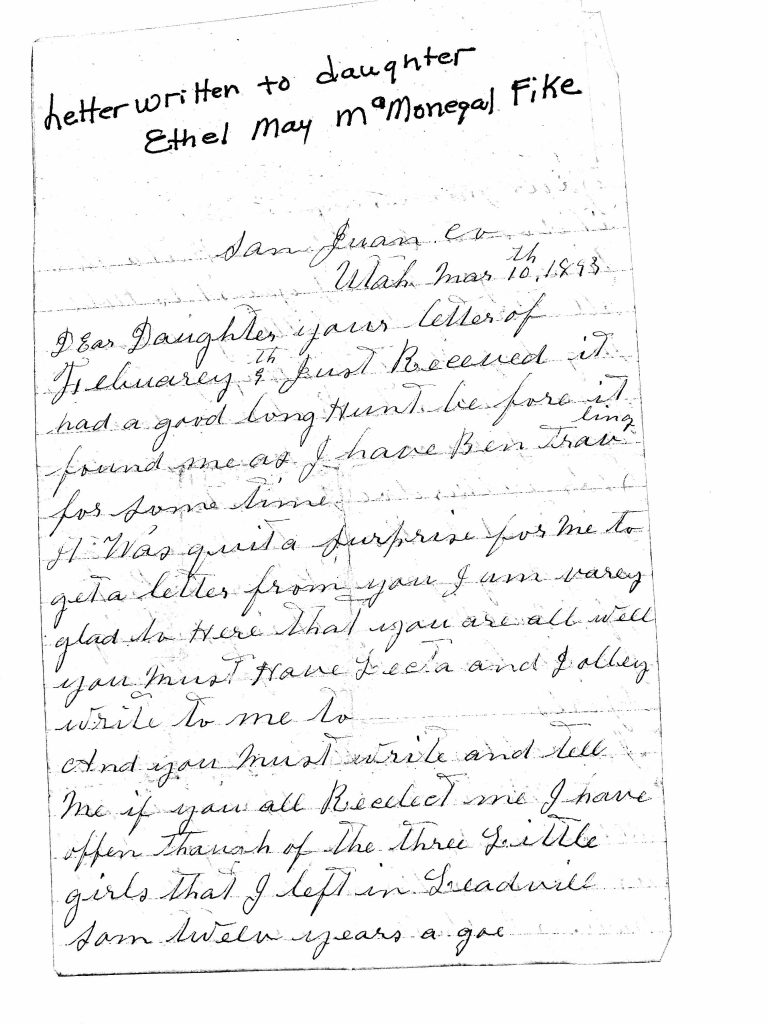
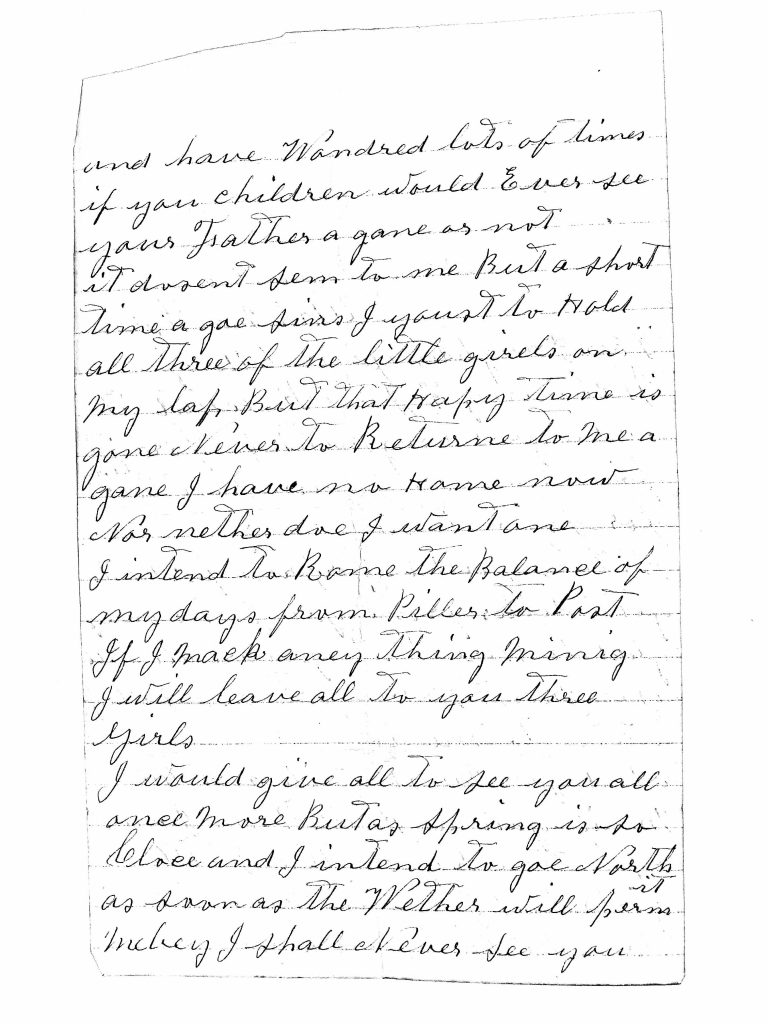
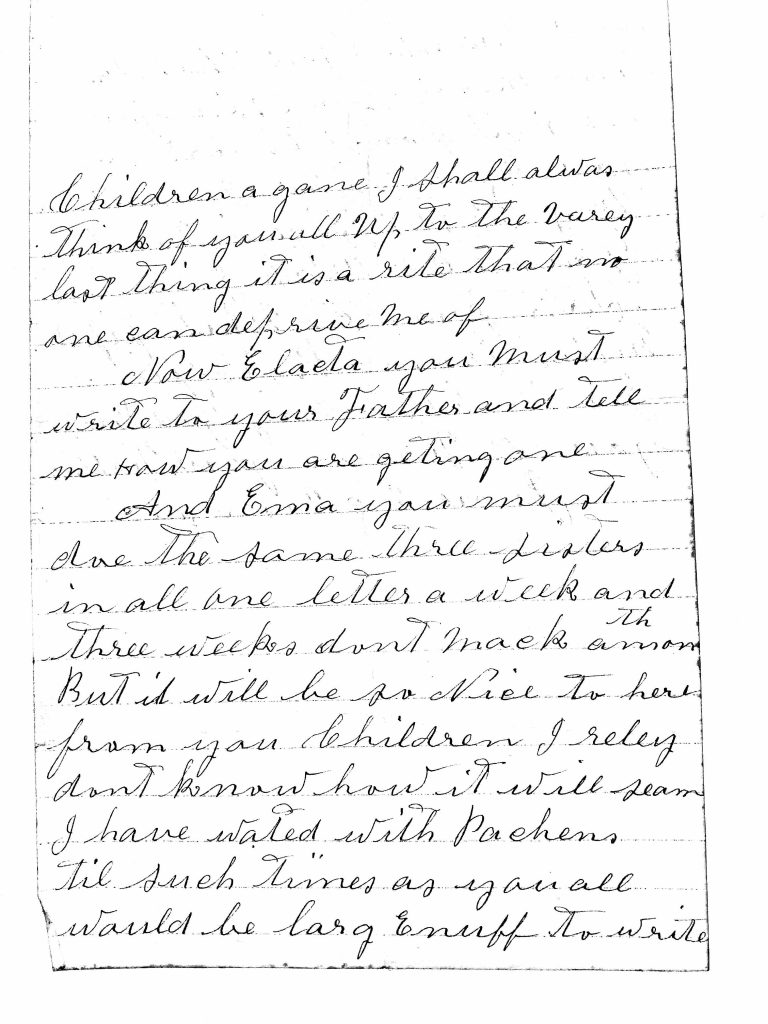
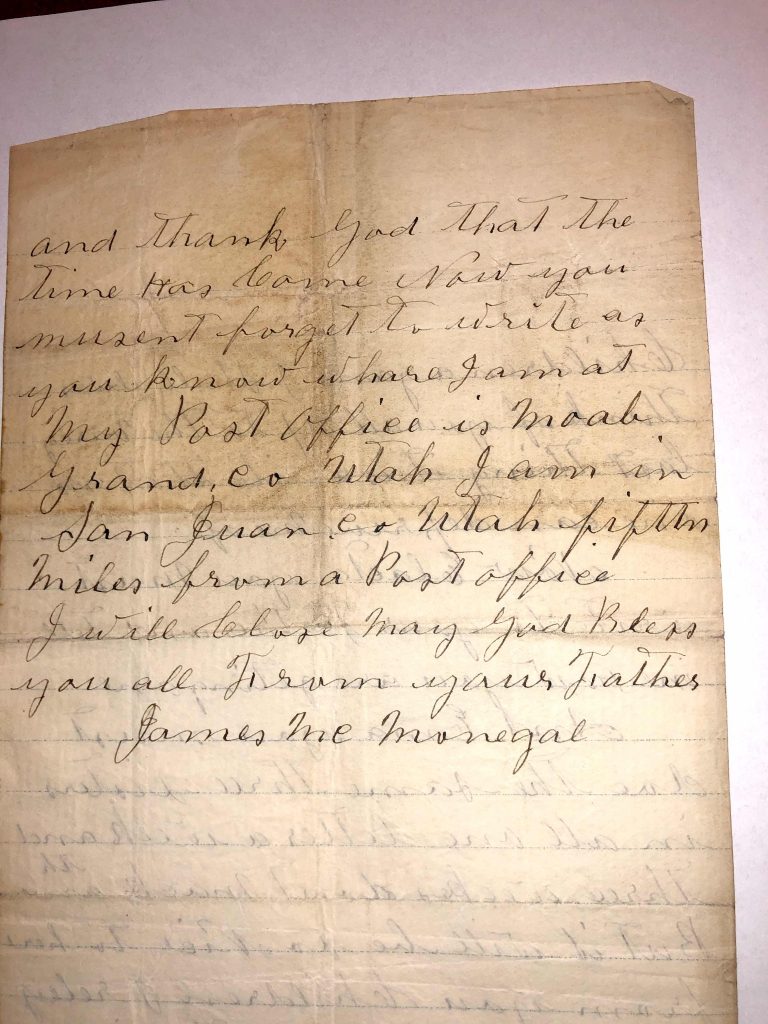
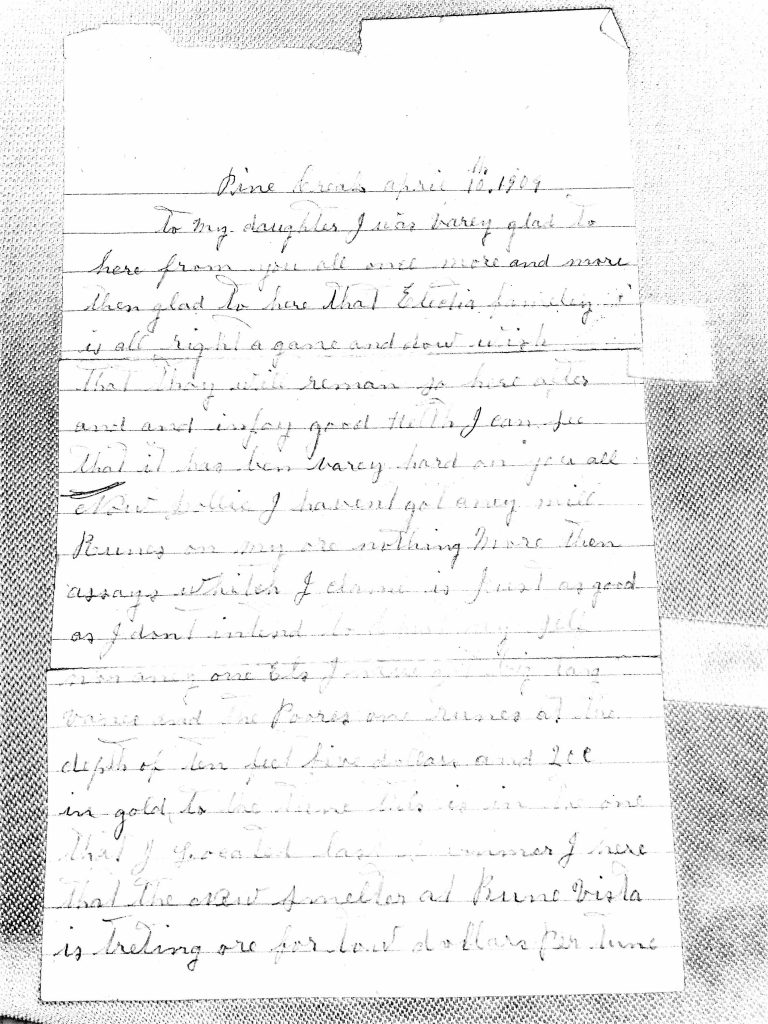
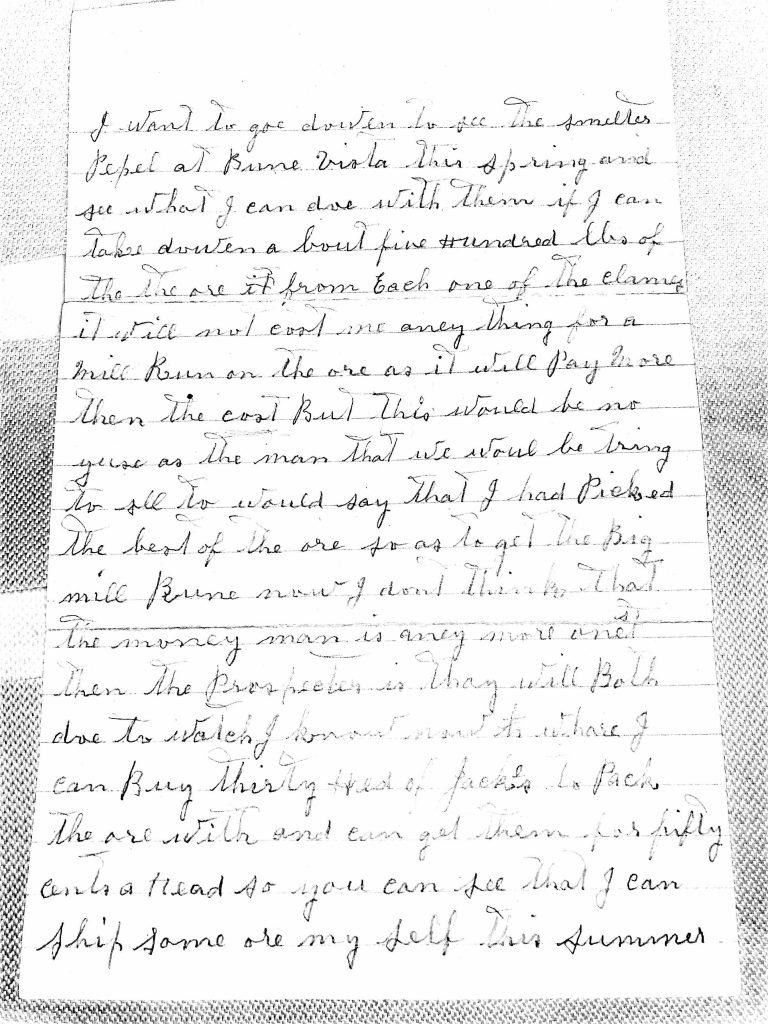
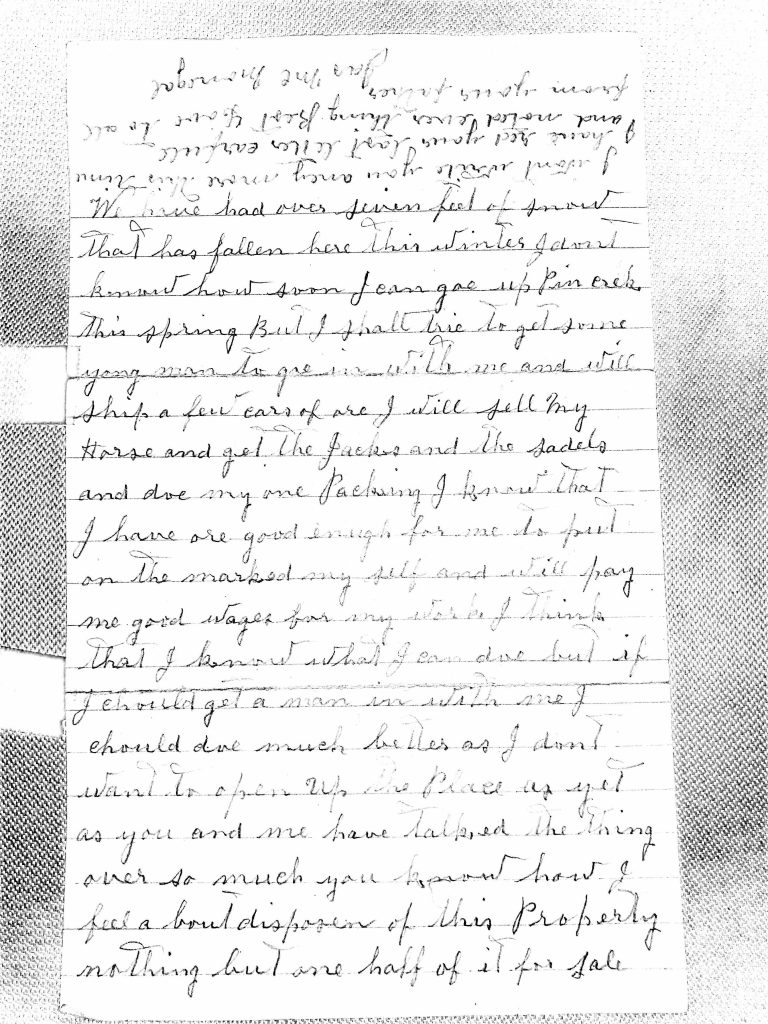
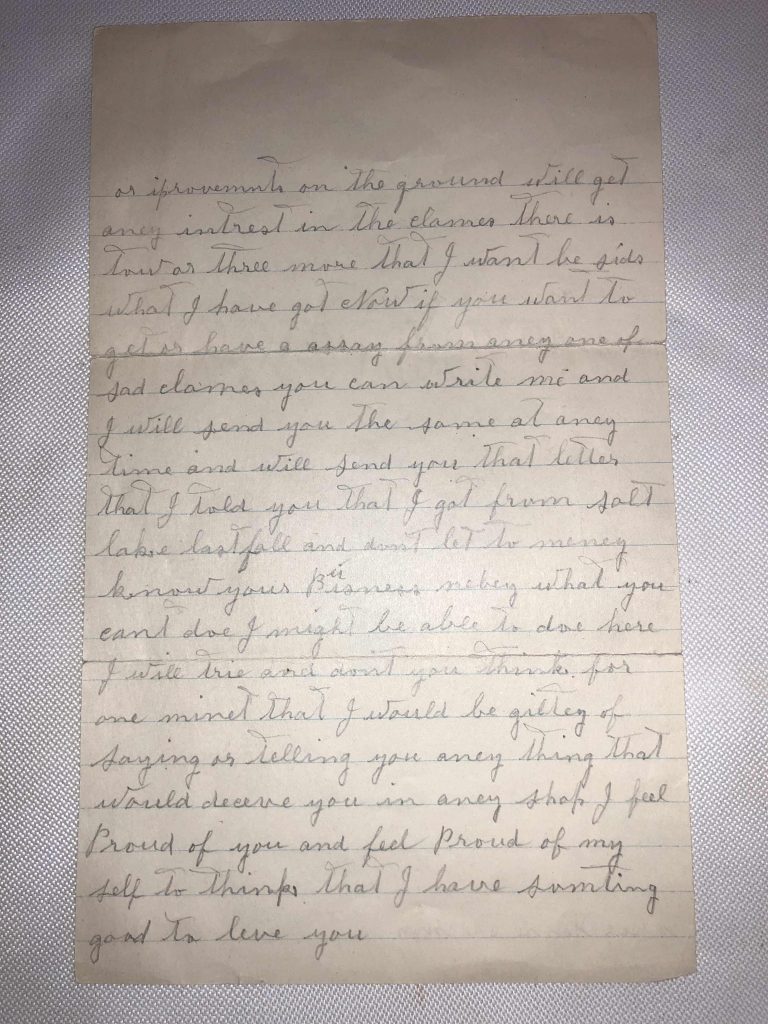
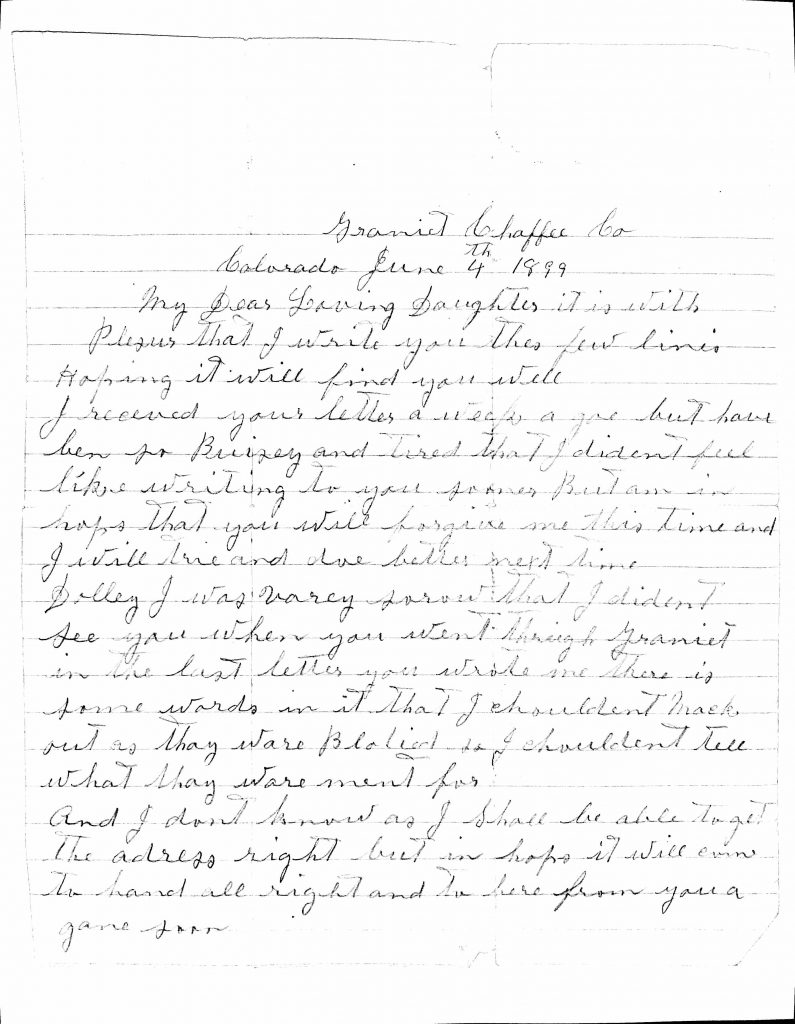
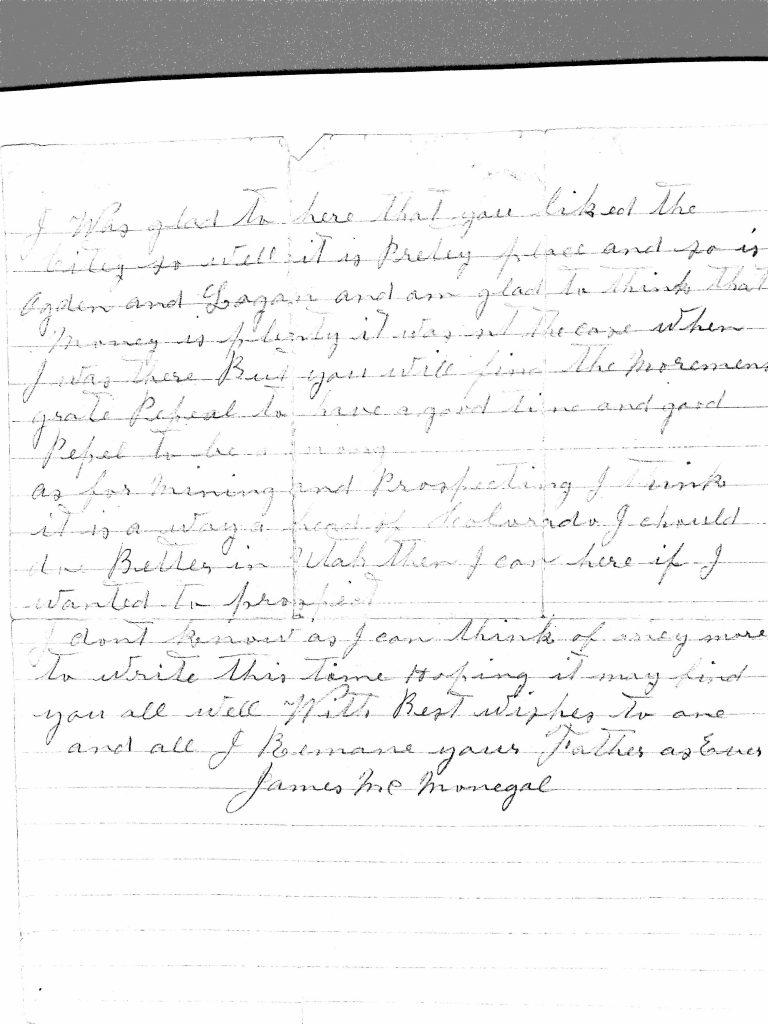
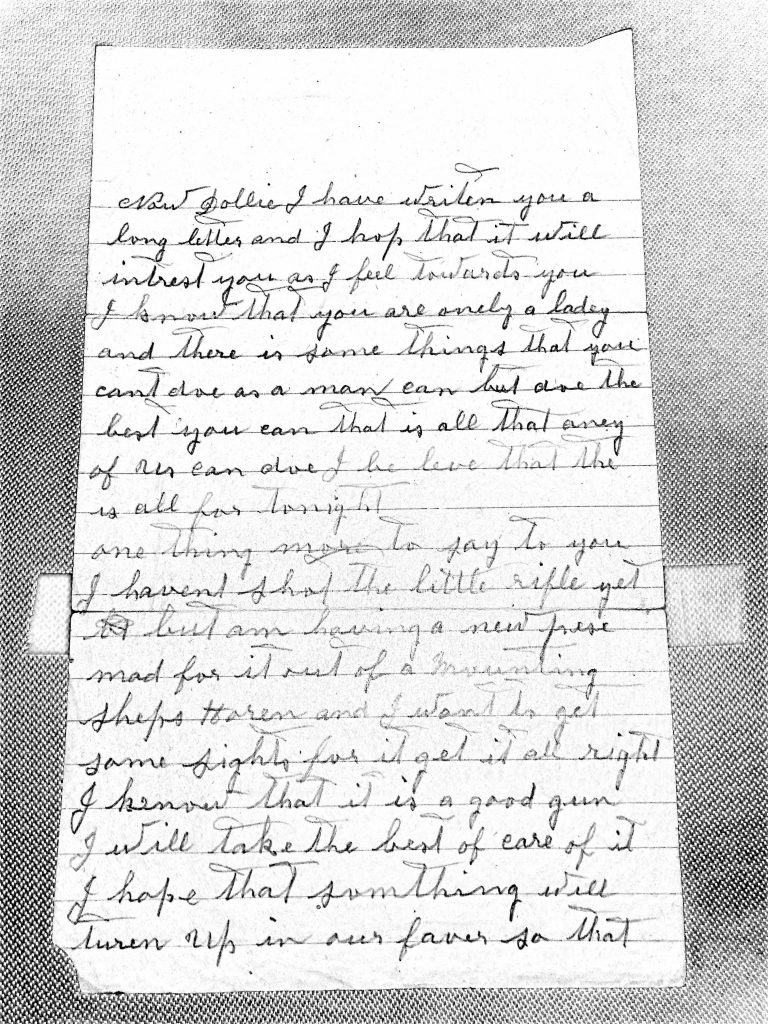

Henrietta Bellen
Henrietta Bellen was born on September 28, 1855,in Rensslear Falls, New York to Electa England, and Anthony Bellen.
In 1874 James McMonegal returned to the St. Lawrence river valley after his Civil War service and a few years working as a teamster in Colorado and married Henrietta in Prescott, Ontario, Canada.
James and Henrietta returned to Colorado where their eldest daughter Ethel (ancestor) was born in Canon City. We can track the movement of the family in Colorado as James worked as a miner.
In 1877 Electa was born in Rocky Ford, Colorado. A year later Dolly was born in Leadville. The city directory shows them living at 826 E. 5th treet and James working as a miner. They are listed in the Leadville city directories in 1880, 1881, and 1882.

In 1866 James and Henrietta divorced. In a letter James talks about leaving the family while they were living in Leadville. The first record of
Henrietta independent from James is an 1891 Denver City Directory showing Henrietta working as a dressmaker. She was listed in the 1891, 1895, and 1899 Denver city directories. By 1902 Henrietta and the girls moved to Salt Lake City.
The 1902 Salt Lake City directory lists Henrietta as a Ladies Tailor at 2223 Mercantile Block Building with her residence at 145 Social Hall Ave., one block Southeast of Temple Square.
In 1907 she was listed as a Dressmaker at 613 Templeton Bldg. (a hotel at Main and S. Temple). In 1911 she was a Dressmaker with business and residence at 735 Major Ave. And by 1919 she was living and working at 817 E. 2nd South. My father and his cousins remember the family living and working in that house.
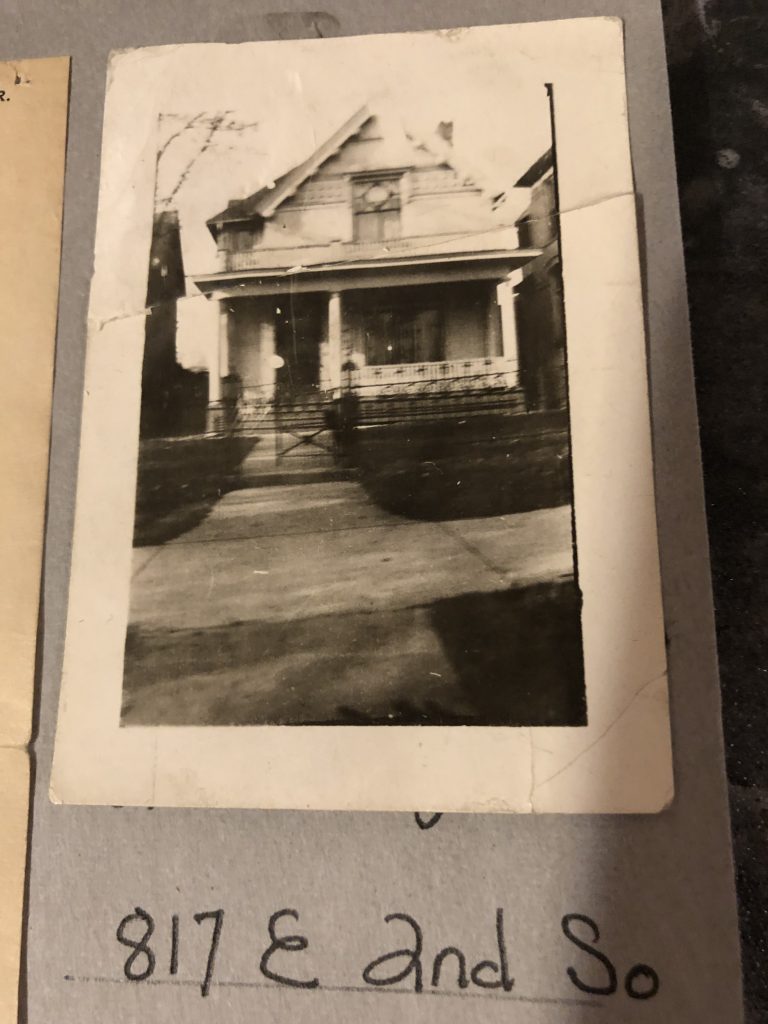
The 1927 directory adds Dolly as the manager of the embroidery shop. and in the 1934-1936 directories Dolly’s name is listed first.
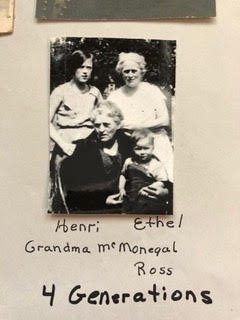
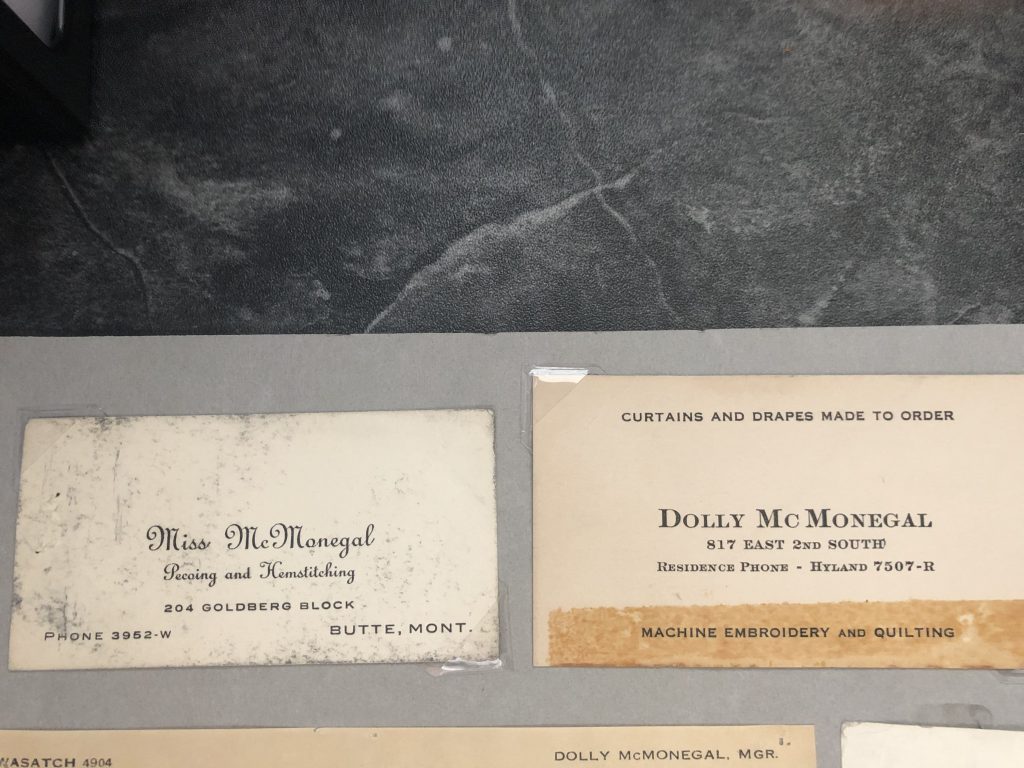
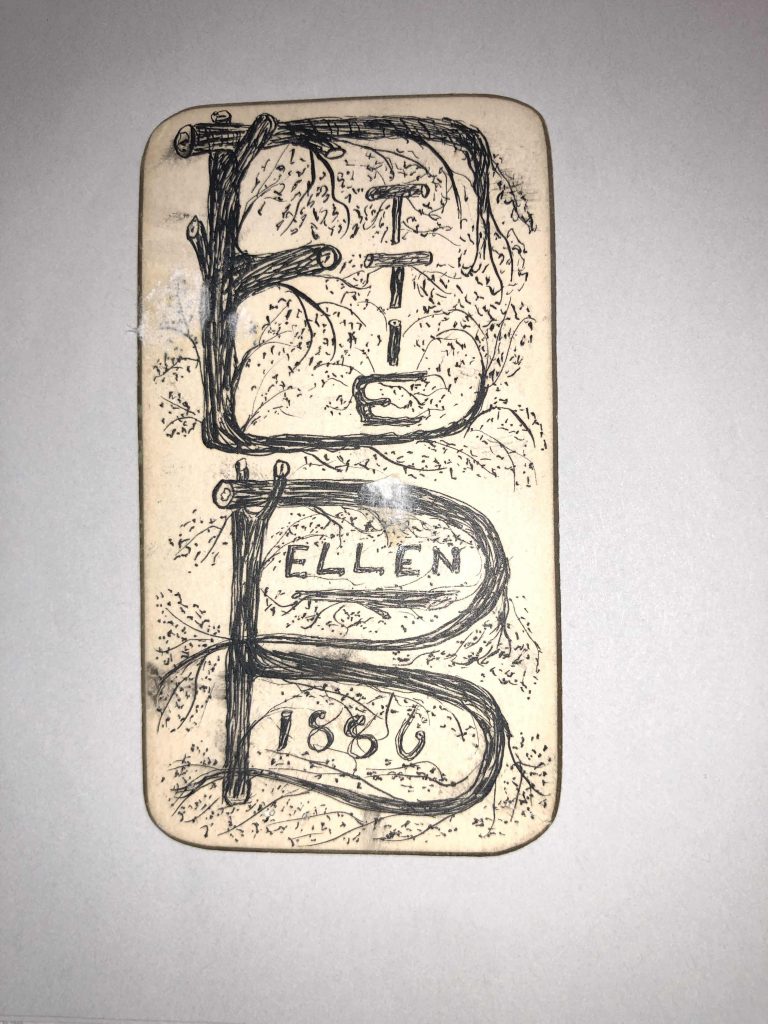
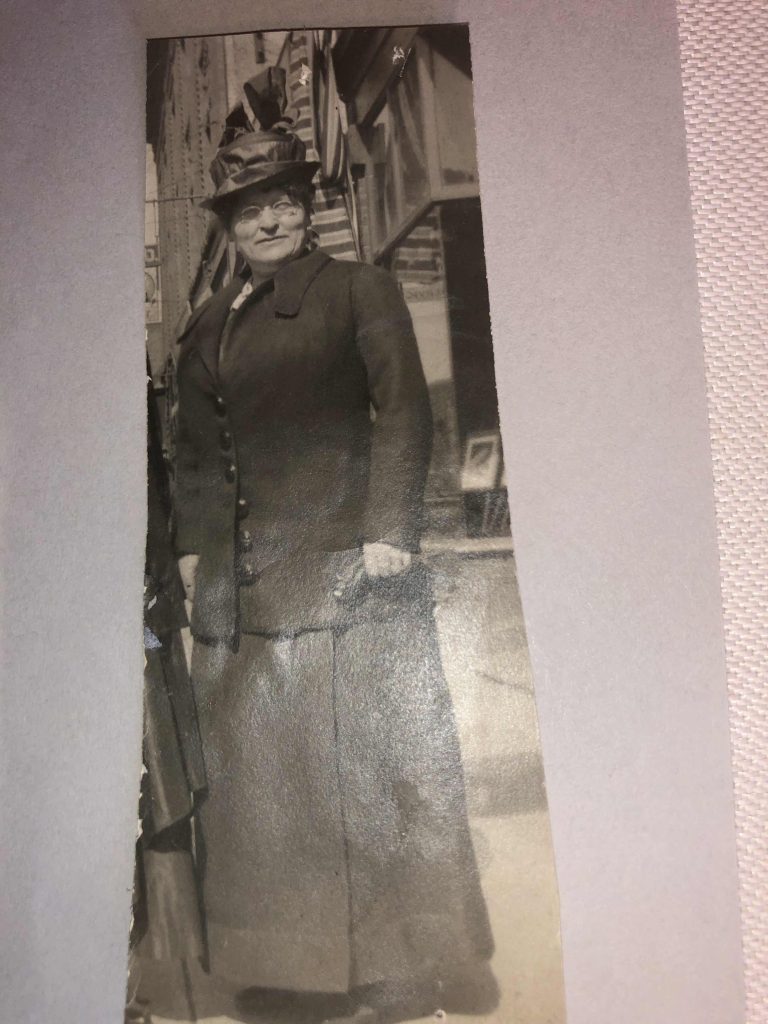
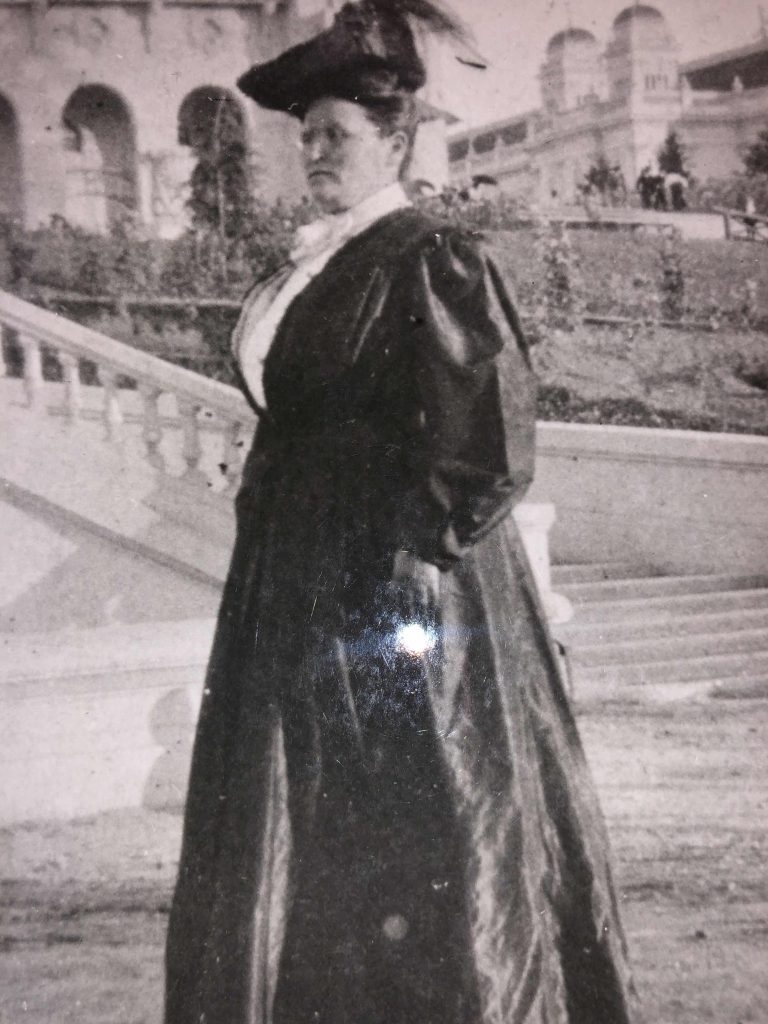
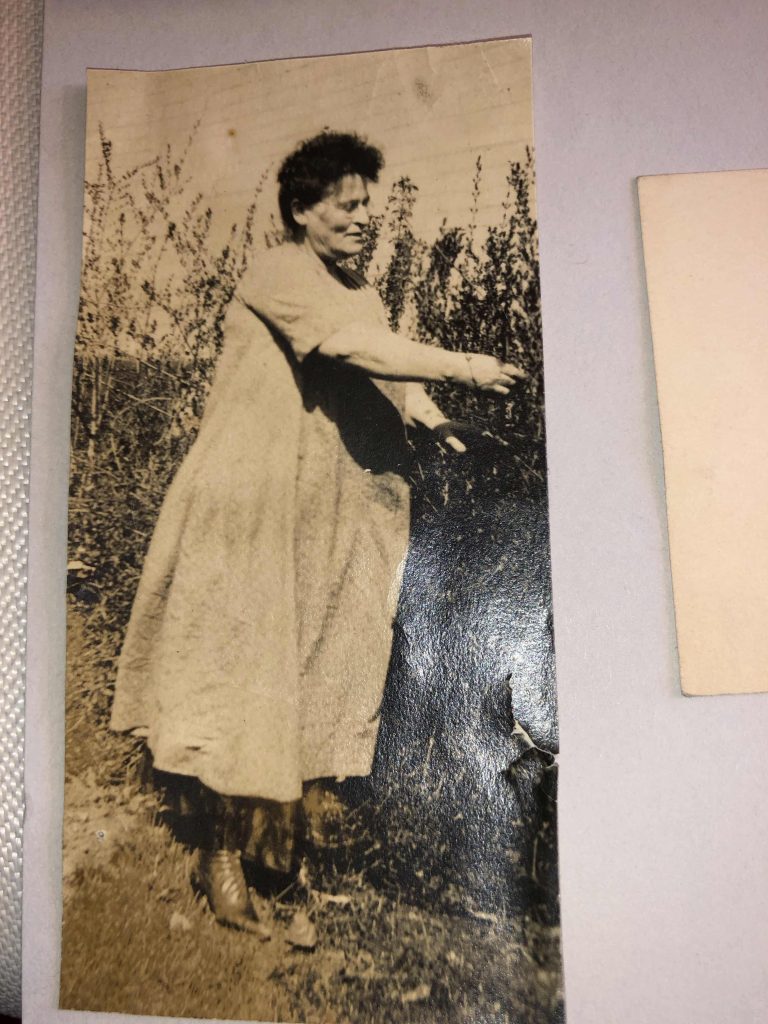
Henrietta died on in Salt Lake City on September 8, 1936 and is interred in the City View Mortuary in Salt Lake City.
FamilySearch ID – KHMK-234
Josiah Achem Fyke and Elizabeth Richardson
Josiah Achem Fyke (1791-1860) Elizabeth Richardson (1789-1850)
My 3rd great-grandfather Josiah Achem Fyke, son of Tyre Fyke and Sarah was born about 1794 in Edgefield Co., South Carolina. He died on 13 Jun 1860 in Marion, Illinois, United States. He married Elizabeth Richardson in 1814 in Robertson Co., Tennessee. She was born about 1794 in Maryland and died about 1860 in Marion Co., Illinois.
Josiah was a grandson of our earliest known Fike ancestor John Thomas Fike. Josiah’s father was Tyre Fike. By the turn of the century (1800) John Thomas and his sons James and John had passed away. Our ancestor Tyre and part of his family moved to South Carolina where they lived out their lives.
Two of Josiah’s uncles, Malachi and Nathan Buford Fyke, and their families were part of the migration westward across the Appalachian Mountains after the Revolutionary War. They moved to Robertson County, Tennessee and Logan County, Kentucky (The two counties are adjacent to each other). The Kentucky land was acquired as a part of the grant that they inherited from the estate of their brother James who died during The Revolutionary War. Our ancestor Josiah Achem Fyke moved west with his uncles. The spelling of the last name changed from Fike to Fyke for two generations. The Fyke name is still seen to this day in Robertson County, Tennessee. Just a few miles north of Nashville you can drive on Fyke’s Grove Road and see the Fyke’s Grove Baptist church.
There are records of land being surveyed in Kentucky for his uncle Malachi in 1805; so all or part of the family had made the move by then. John (Josiah’s cousin) married in Kentucky in 1808 and died in Tennessee in 1826. Malachi’s will is dated 1810.
Josiah’s wife Elizabeth Richardson’s parents, John and Sarah, were born in Maryland and migrated to North Carolina after the Revolutionary War. Their middle children were born in NC, and then they moved to Robertson County where their youngest son was born in 1808. We know that the Richardson’s and some of their family moved to Illinois with the Fykes. There was another family by the name of Wooter’s who were neighbors and inter-married into the Fyke and Richardson clans in Tennessee and made the move to Illinois, and in the next generation, onto Missouri.
The migration west began before the Revolutionary War (1775–1783), as adventurous North Carolinians followed Daniel Boone in search of new frontiers beyond the mountains. After the war veterans of the Revolution were rewarded with free land in what became Tennessee.
Our family crossed the Alleghenies only 20 years after Daniel Boone first guided pioneers through the Cumberland Gap into the Kentucky wilderness. The westward migration of our family that started in colonial Virginia continued for three more generations. Josiah Achem moved from North Carolina to Tennessee to Illinois. His son Thomas Lanman moved from Illinois to Missouri. And his grandson Josiah Walter completed the migration from Missouri to Utah. The westward movement occurred for our family, and for many others, as lands were open for settlement by the US government and as the local Indian populations were subdued or driven from their lands.
Our Fike ancestors were early pioneers in each of these counties. They arrived within a decade of the states being admitted to the union and of the counties being formed. The populations were sparse, but land was cheap or free to people willing to clear it and develop productive farmland. They built their homes by hand and migrated by foot or ox cart.
The people we read about as heroes of the frontier lived in these same time and places. Sam Houston was born in Virginia in 1793 (One year before Josiah Achem Fyke). He moved to Blount County TN in 1806 and was fighting for Andrew Jackson at the battle of Horseshoe Bend in 1814. Josiah Achem fought for Jackson in a different regiment at the Battle of New Orleans. Sam Houston served in government and military positions and earned a law degree in Nashville between 1814 and 1823 when he was elected to congress. The location of Fyke’s Grove is about 40 miles north of Nashville, so Josiah Achem and General Sam were contemporaries. Sam represented Josiah in Congress.
Josiah and Abraham Lincoln both moved to Illinois in 1830, a year where the state’s population was 157,445. George Custer wasn’t born until Josiah Achem had been settled in Illinois for a decade, and Josiah’s grandson, Josiah Walter, was working as a cowboy in Nebraska only nine years after Custer died at the Little Big Horn.
In 1830 Josiah, Elizabeth, and their family and friends moved to Marion County Illinois. The book “The History of Marion County Illinois” has the following section about Josiah Fyke:
“Josiah Fyke, a veteran of the War of 1812, one of General Jackson’s Tennesseeans, at the battle of New Orleans, settled in section 17, in 1830. He was the first Justice of the Peace in the township and served in the Black Hawk war. Several of his descendants still reside in this township and a few in other townships of the county. “
The National Archives records of the War of 1812 have the following entry:
Josiah Fike – 2nd Reg’T Mounted Gunmen (Williamson’s (Colonel Thomas Williamson)), Tennessee Volunteers. Private. Dates: September 1814 – April 1815. Made up of men mostly from Bedford, Davidson, Robertson, Rutherford, Sumner, Williamson, Wilson, Giles, and Smith Counties.
Brief History: Along with Colonel Robert Dyer’s unit, this regiment was part of General John Coffee’s brigade that fought at Pensacola and New Orleans. Marching from Fayetteville to Camp Gaines (30 miles from Fort Montgomery), they helped Jackson take the port of Pensacola from the Spanish on 7 November 1814. Williamson’s men then participated in all of the engagements at New Orleans, where they were part of the left line of Jackson’s breastworks. In March 1815 they returned to Tennessee via the Natchez Trace.
Also from “The History of Marion County Illinois”:
“…The first US census lists two Fykes. They had settled on the mountain slopes of North Carolina and later moved to Robinson (Robertson) County Tennessee. In 1830 Josiah Fyke and his wife , Betsy, were lured by the rumor of rich prairie lands to what was then known as Tennessee Prairie in Illinois. At the time settlers were rushing to the westward country for the red men had ceased giving trouble and the land could be bought from the government for 75 cents per acre. Josiah Fyke, his wife, their two children and two devoted colored people, who formerly had been their slaves acquired a homestead in section 17, in what is now Centralia Township. Here they built a home, reared their family, and spent the remainder of their lives.
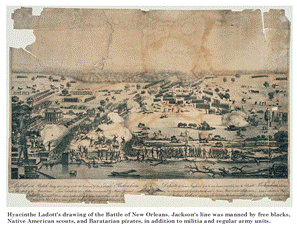
Federal Census Records for Josiah:
1830 – Rhea (?), TN: 1 male under 5; 1 male 20-30; 1 male 50-60; 1 female under 5; 1 female 5-10; 1 female 10-15; 1 female 15-20; 1 female 30-40.
1840 – Marion Co., IL: 2 males under 5; 2 males 5-10; 1 male 15-20; 2 males 20-30; 1 male 40-50 (Josiah, 46); 2 females 10-15; 1 female 40-50 (Elizabeth, 46) 1850 – Marion Co., IL, very near to the home of William & Ann Clark (Elizabeth’s sister).
1850 – U.S. Census Illinois Marion District 11 Josiah Fyke 56 NC Elizabeth 56 MD Joseph 18 IL Thomas 16 IL Elisha 14 IL
1855 – Marion Co., IL: 2 males 10-20 (Elisha, 19; Thomas, 22); 1 male 20-30 (Joseph, 23); 1 male 60-70 (Josiah, 62); 1 female 10-20; 1 female 60-70 (Elizabeth, 61)
The following excerpts about our ancestors Josiah Achem Fyke and Elizabeth Richardson are from “Footprints in Marion County” volume 2, Number 4, Spring 1978. This is the publication of the Marion County Illinois Historical Society:
“Raccoon Township is the southernmost of the second tier of townships in Marion County, Illinois, east of the 3rd principal meridian. The name was taken from the creek that meanders through the township and this was no doubt named for the numerous raccoons that lived there. Small glades of prairie land project into the township, among which are Walnut Hill, Romine, and Tennessee Prairie, although in an earlier time more than half of the land was covered with forest. The first man to settle on Tennessee prairie was Alfred Ray and so many of the early settlers from the state of Tennessee gave the prairie its name.
Two families from North Carolina settled near Walnut Hill, Sherwood and McKenney. John Adams came from Kentucky in 1828 and settled in Raccoon Township. John Wilson settled section 32 in 1819, Josiah Fyke, a veteran of the War of 1812, one of General Jackson’s Tennesseans at the battle of New Orleans settled section 17 on 1830. He was the first Justice of the Peace in the township and served in the Black Hawk War…”
The following account was written in the 1960’s by one of Josiah’s great granddaughters, Ethel Fyke Kniseley, which can be found in the same Marion County history. Ethel was a charter member of the Marion County Historical Society.
This writer recounts the common family story that the early Fike’s came from Germany before the Revolutionary War. The references to Josiah, Squire Joe, and Aunt Betsy are to our ancestors Josiah Achem Fyke and Elizabeth Richardson:
Fyke Cemetery
“Historical facts about the graveyard located Sec. 17, Raccoon Twp. A plot of land where who-so-ever-will may come for his free and final resting place was established in each pioneer community. On an elevation 1/2 mile from a public road, Josiah and Aunt Betsy Fyke set aside one acre of land, surrounded by an orchard, clover, and corn fields where our ancestors lie undisturbed.
Squire Joe Fyke, a learned man who fought in the war of 1812, the Black Hawk War, and The Battle of New Orleans, settled in Sec. 17 in 1830. Lying at his side is his wife and Margaret Wilson Fyke said to be the first white child born in Marion County. Aunt Marg lived to be near 100 from 1822 to 1922. Many were the tales of pioneer days which she related to us. As a young girl she remembered walking from her home in Sec. 32 (Bundyville) to the Phillips to borrow a kettle of coals. She remembered then that there were few if any housed between her home and Carlyle. Then farmers drove hogs to St. Louis, forded the Mississippi River, as well as great flocks of turkeys to the French City market. Fascinating to me was the story of her dropping the kernels of corn in a trench plowed by squire Joe, the seed bed having no preparation nor was there any cultivation since the virgin soil was loose and fibrous. Waiting at the starting point would be a young child looking forward to a feeding after the mother’s half-mail round. Once she found a large acorn (sprouted) which she carried home in her jacket and planted near the cabin. Today a lofty oak well 3 feet in diameter lifts its huge branches toward the sky. Such a beautiful tree – and a living monument to this good woman’s thrift and foresight. At 90 years she cut in her wood. She never had a toothache or a dentist. Squire Joe raised a fine family of professional men, doctors, lawyers, business men. Josiah (their adult son) his good wife and their children lie nearby.
One great-great grandfather and wife form the next row as do their children who died in infancy. There were 9 children who grew to adulthood. In a handwritten will Grandfather Josiah made some strange bequests. “To my beloved wife Betsy I leave the homestead of 80 acres, my gray horse, saddle and bridle, one cow and calf, one brass bed and bedding. To his 5 sons he gave land and to 4 daughters $50.00 each and any remaining after debts were paid. The daughters were evidently uneducated theirs was always an X signature, but all of the sons wrote legibly. We think our grandmother’s maiden name was Richardson. “
The author continues on about her parents and then finishes with this section about the Fyke origins:
“History recalls the Fykes, Klinerts, Binkleys, Freys, Stotltz, Fishers, Kiger, Kinkles, Felts families left Germany shortly before the Revolutionary War and settled in the mountains of westen North Carolina, but in the early 1800’s they went to Robertson County Tennessee. Today there are many Fykes living there.”
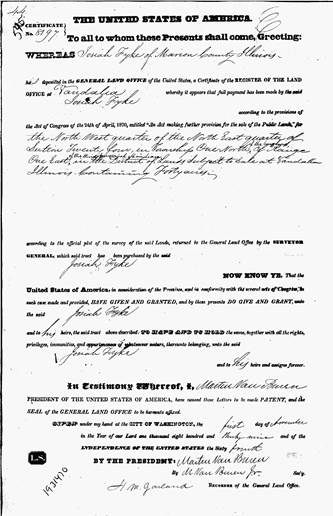
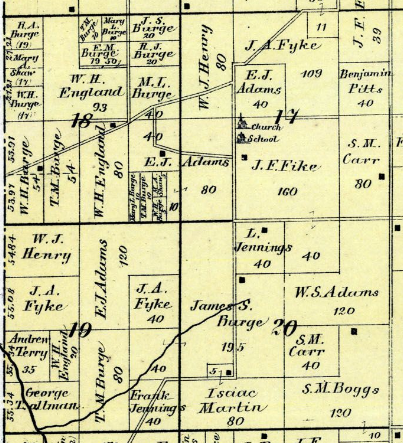
These sections are within a 2 mile radius of the present day intersection of I-57 and Hwy 161.
From The Centralia Newspaper Article dated 1965 with some corrections:
“Josiah A Fike, with his wife, Betsy, were lured by the rumors of rich prairie lands to what was then known as Tennessee prairie, in Illinois. At that time settlers were rushing to the Westward country for the Red men had ceased giving trouble and the land could be bought from the government for 75 cents per acre. Andrew Jackson was President, and although he had recommended to Congress that the President be limited to one term, his friends were working for his nomination for a second time, and the South felt that the differences that were already causing friction between the North and the South, would be settled in a way that would give the South the things they wanted.
Moving a few hundred miles in that day presented many problems. The cattle were driven along the trails with bells attached to them so they could be located if they strayed from the herd while grazing. Only necessary items were carried to the next home in the wagon, such as seed for the first crop, some crude implements and furniture. The wagons were drawn by oxen. Several families made the journey together, and only a few miles could be covered in a day. As the sun sank low in the west, the wagons would come to a stop at a creek or a branch where water and wood could be secured and a camp would be made for the night. A campfire would be built, and the skillets brought out. While the women prepared supper, the men arranged the livestock for the night, talked over the adventures of the day and speculated on the next days possibilities.
Josiah, his wife, their five children, and two devoted colored people, who formerly had been their slaves, acquired a homestead in Section 17 in what is now Centralia Township. Here they built a home, reared their family, and spent the remainder of their lives. The family cemetery on the farm is the final resting place of the older generations and the two loyal colored people. ( Aunt Celia, a negro mammy, is buried in thw SW corner.) A school was built on the bank of a small branch that ran through their farm. Children came from miles around to attend the school. They called Mr. Fike “Uncle Dr. Joe” for he was never too busy to wrap up their cuts or set a broken bone.
With the passing of Josiah & Betsy, their son, Joseph Frazier, acquired the home place and shortly after the Civil War, built the present brick home (the bricks were burned on the farm) with its 13″ walls and its hand carved woodwork. Joseph was a stock and grain farmer growing principally, wheat. The thrashing was done by horse powered thrashing machines. The Fikes gave land for a school, church and cemetery. Should it cease to be used for those purposes, it will revert to the original farm. The farm was passed on to Norman Fike and then to his daughter, Mrs. David (Maude) Foster who was living there, with Mrs. Norman (Mary) Fike, at the time of this article. Listed in the article as grandchildren are: Bess Cover, Pearl Stockman, Ruby Fike, Media Hankins, Nellie Watts, Weiser Fike, Merritt Ray, and Orpha Hopkins.
——————————————————————————————————————————————————————- Josiah A. “Uncle Joe” (1794-1860) was a veteran of the War of 1812. He was one of Gen. Jacksons Tennesseans at the battle of New Orleans. He settled in Marion Co. Illinois is 1830. He was a farmer and the first Justice of the Peace in Marion Co.. He also served in the Black Hawk War. He married Elizabeth “Aunt Betsy” Richardson in 1794 and they had 9 children. The first 5 children were born in Robertson Co. Tennessee.”
FamilySearch ID: Josiah Fyke – L4QT-GM2 Elizabeth Richardson – G9FL-68V
Thomas Henry and Sarah Stark
Thomas Henry was born in 1807, in Tennessee. His father, Hugh Henry Jr, was 56 and his mother, Elizabeth Tamnasson, was 29. He married Sarah Sally Stark in 1830, in Robertson County, Tennessee. He lived in Robertson, Tennessee, in 185o. He died in 1876.
Sarah Sally Stark was born in 1812, in Robertson County, Tennessee, United States, her father, Walter William “Wattie” Stark, was 21 and her mother, Mary Magdalene Woodard, was 17. She married Thomas Henry in 1830, in Robertson, Tennessee. She died in 1883, at the age of 71.
Henry, Stark, and Donelson ancestors were Revolutionary War patriots and founders of Nashville, Tennessee. You can learn about them by following this link.
Thomas’ FamilySearch ID – MPJB-68G; Sarah’s 2SQP-46N
Anthony Bellen and Electa England
Anthony Bellen (1823-1903) Electa England (1833-1925)
My 3rd Great-Grandmother Electa England was born March 4, 1833 in Massena, St. Laurence Co., New York, in upstate New York, near the St. Lawrence River just South of the Canadian border. Both of her grandfathers fought in the Revolutionary War on the British side. After the war, their families along with many British Loyalists were forced to relocate to Canada (link to Revolutionary War Soldiers). Electa’s parents, Robert England 1791-1875, and Betsy Phillips 1796-1870, were born in Quebec, Canada and were married in 1810. By at least 1816 they were living in St. Lawrence County, New York where their oldest daughter, Polly, was born.
Electa was the 10th of 12 children born to Robert and Betsy. Both of her parents lived the remainder of their lives in Massena, St. Lawrence Co., NY.
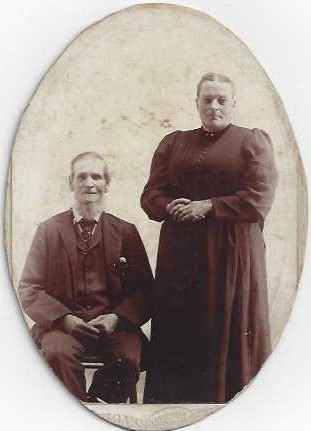
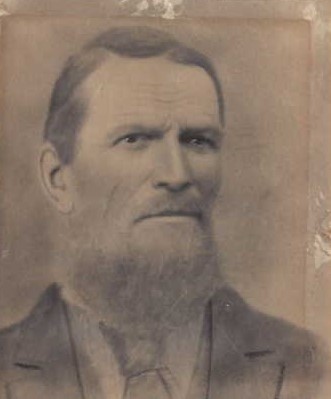
Electa married Anthony Bellen (1823-1903) on 4 April 1854 in Hermon, St. Lawrence Co., NY. They settled in Canton, New York and our ancestor, Henrietta Bellen, was born to them the next year. They were living in Canton in 1860. Electa and Anthony went on to have 8 more children. They are both buried in Rensselaer Falls, New York Cemetery in the right side section.
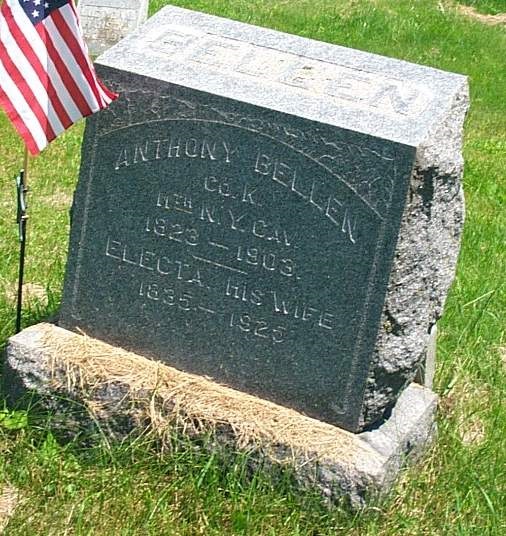
Both Anthony and their son-in-law, the Irish immigrant, James McMonegal fought in the American Civil War. Anthony Bellen was a Civil War soldier in Co. K of the 11th New York Cavalry.
Electa’s paternal grandparents were William England 1740-1796, an English immigrant and royalist soldier, and his wife Mary Schneider 1751-1838. Mary was a third generation colonist whose grandparents were part of the Palatine German migration to New York in 1709.
Her maternal grandparents were John Phillips 1751-1844, also a royalist British Soldier in the Revolutionary War and his wife Isabella Finney 1762-1849. John Phillips’ father was descended from Dutch immigrants who arrived in New Amsterdam and migrated to the Hudson and Mohawk valleys Link to our Colonial Immigrant Ancestors. His mother was descended from Puritan and Separatist English fleeing religious persecution. Most famously, we are descended from Thomas and his son Joseph Rogers; two of the 102 passengers to arrive in Plymouth Harbor on “The Mayflower”. This link will take you to our Mayflower Ancestors on the Colonial Immigrant Ancestor page.
Anthony’s FamilySearch ID – M5QS-Y6X; Electa’s – M5QS-Y6L